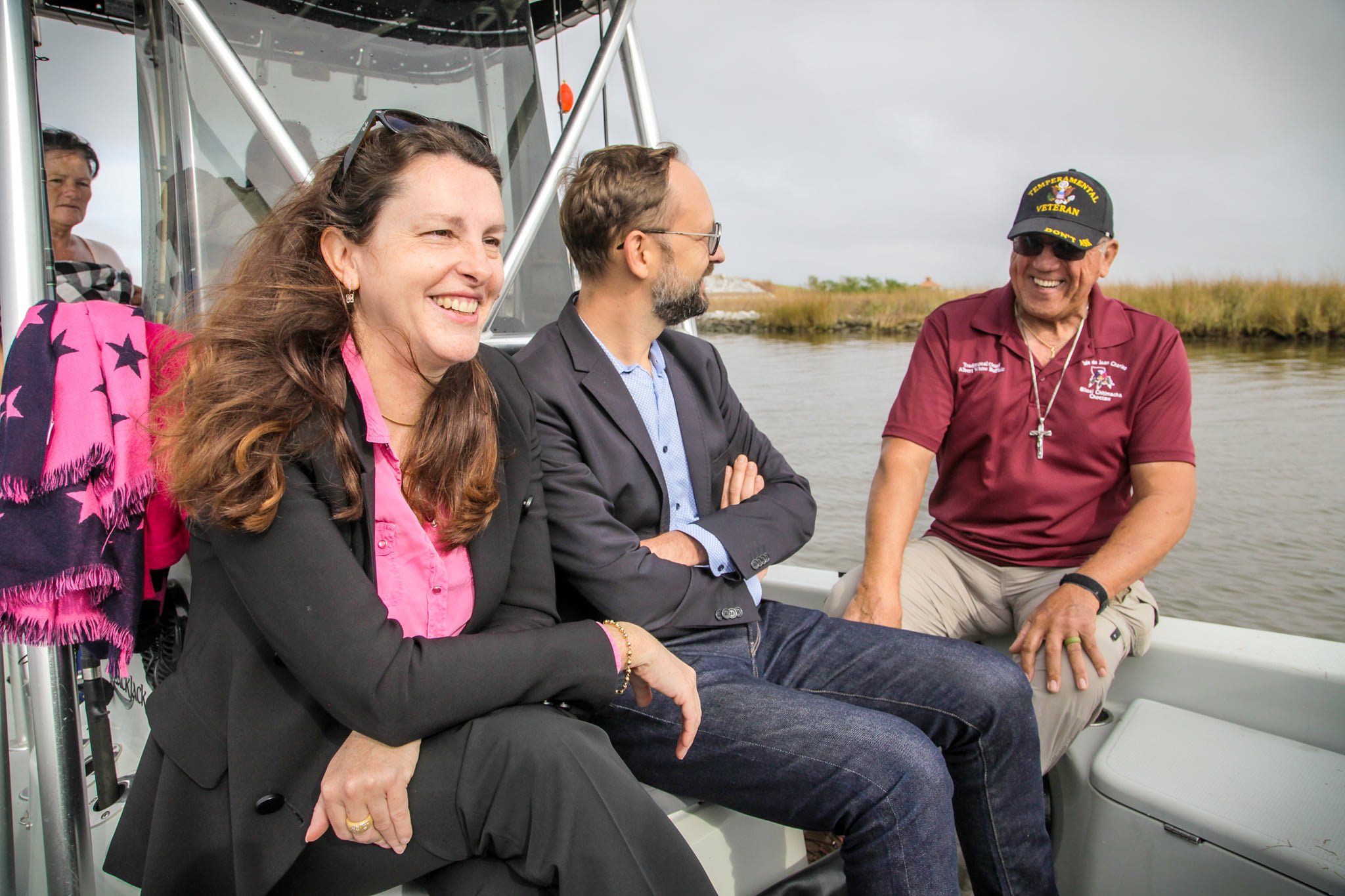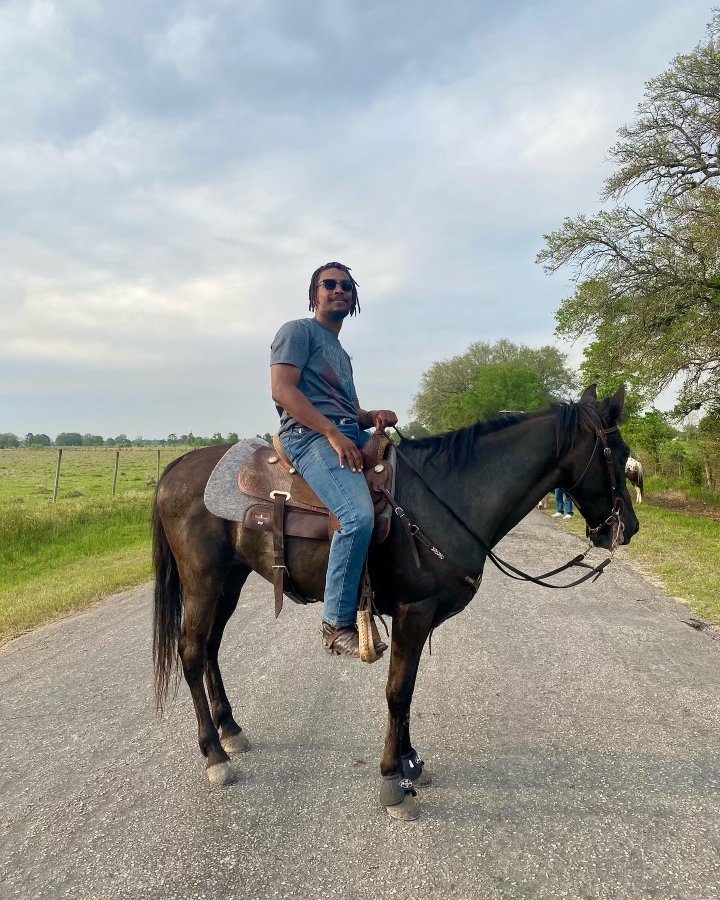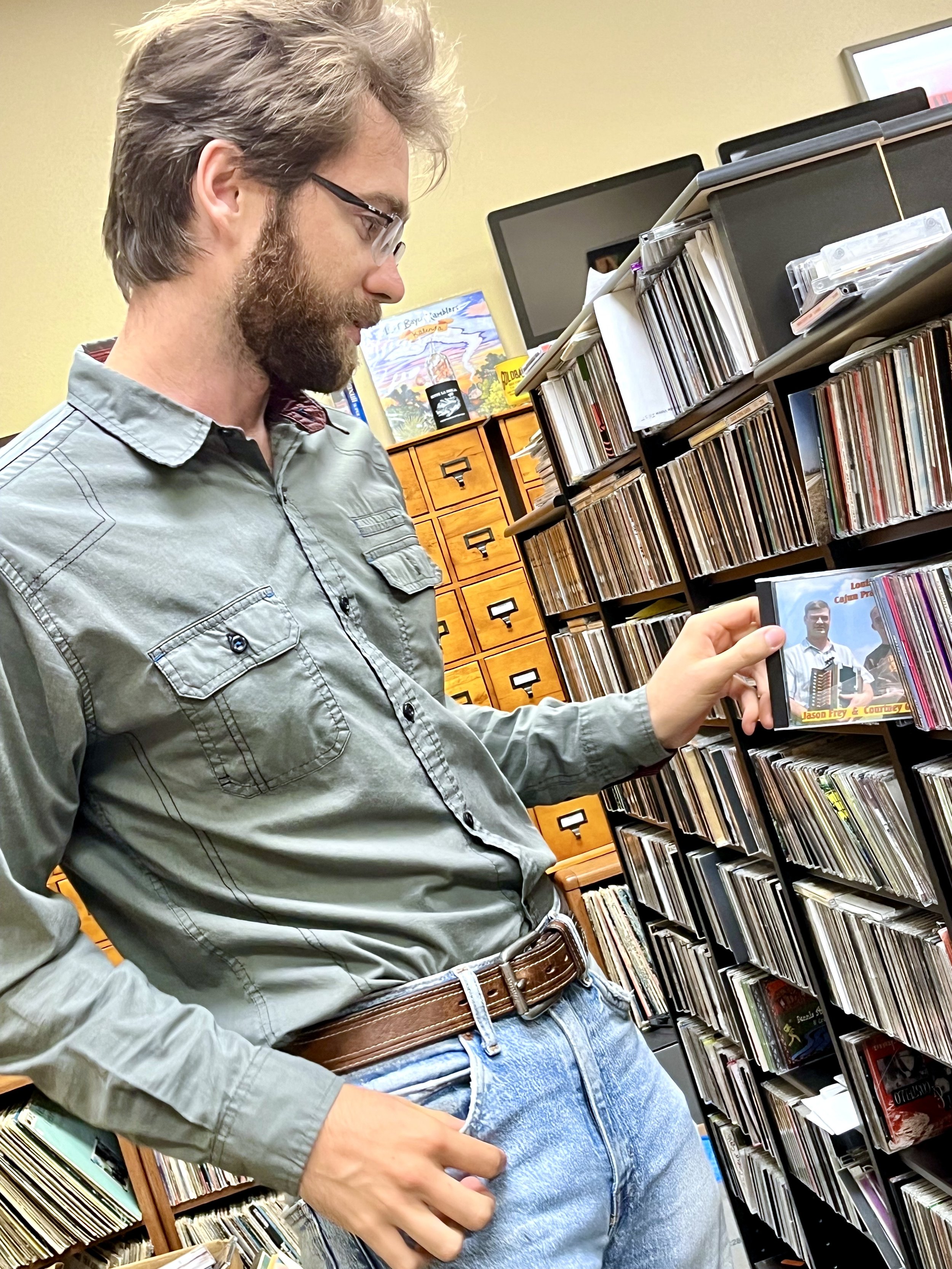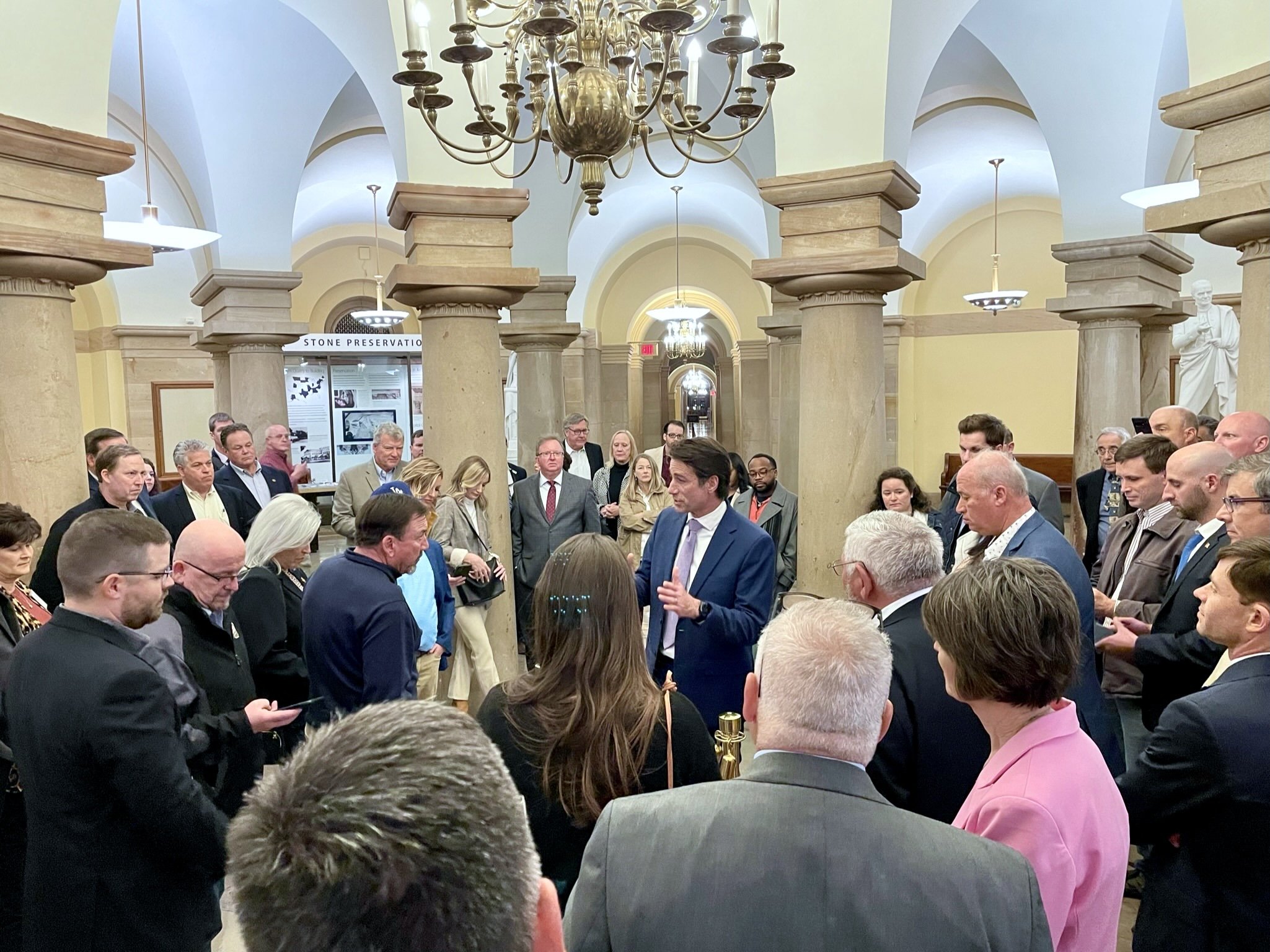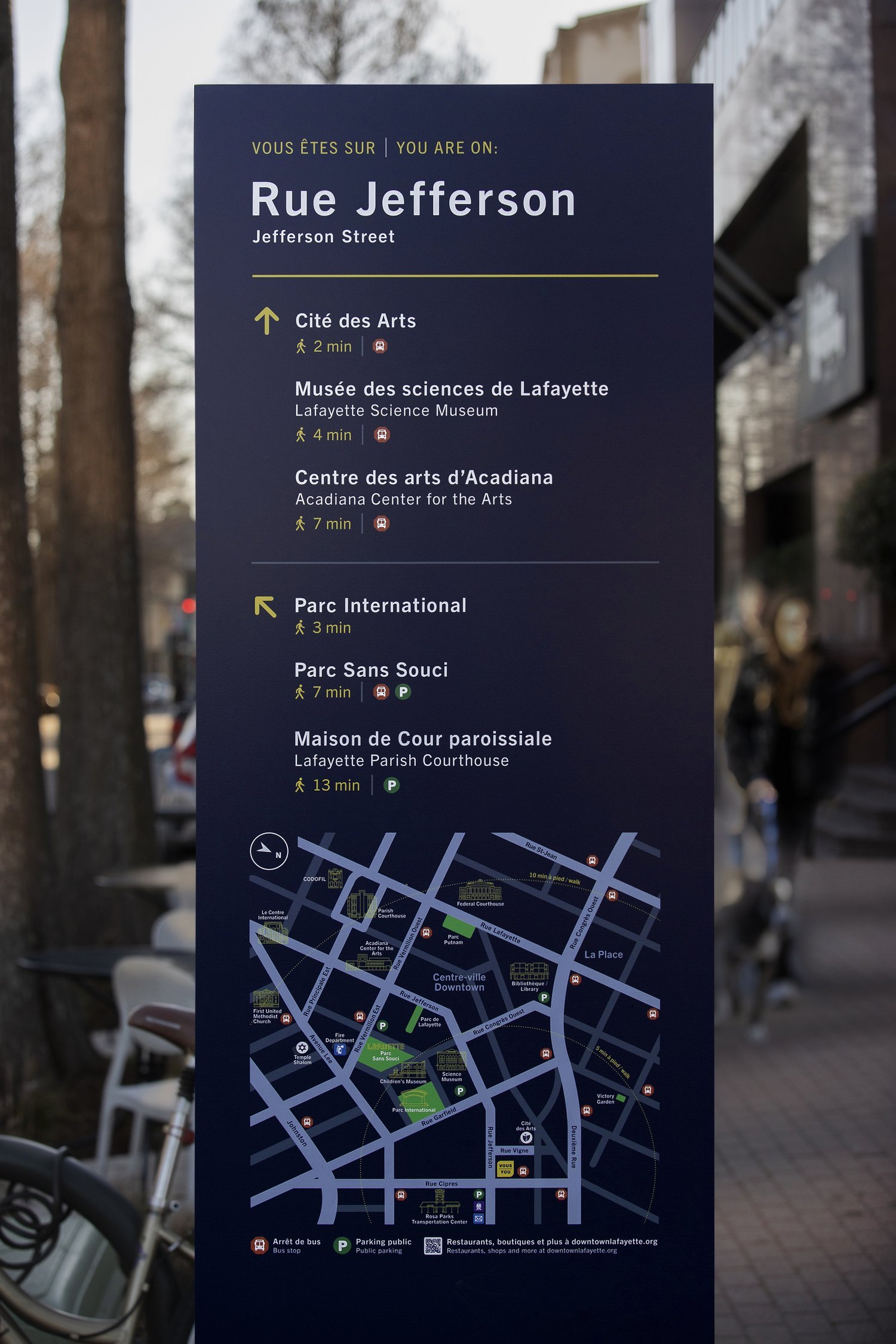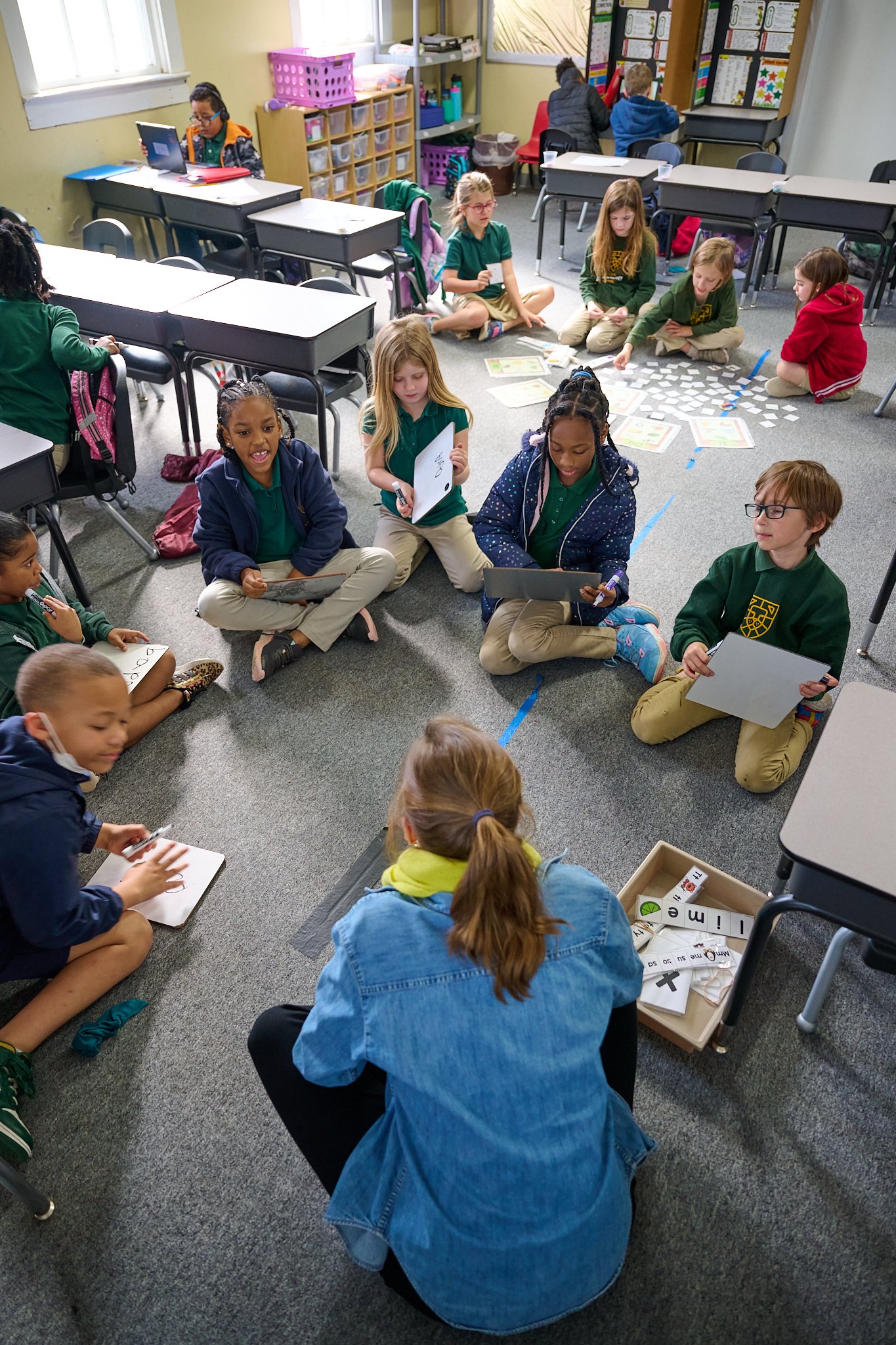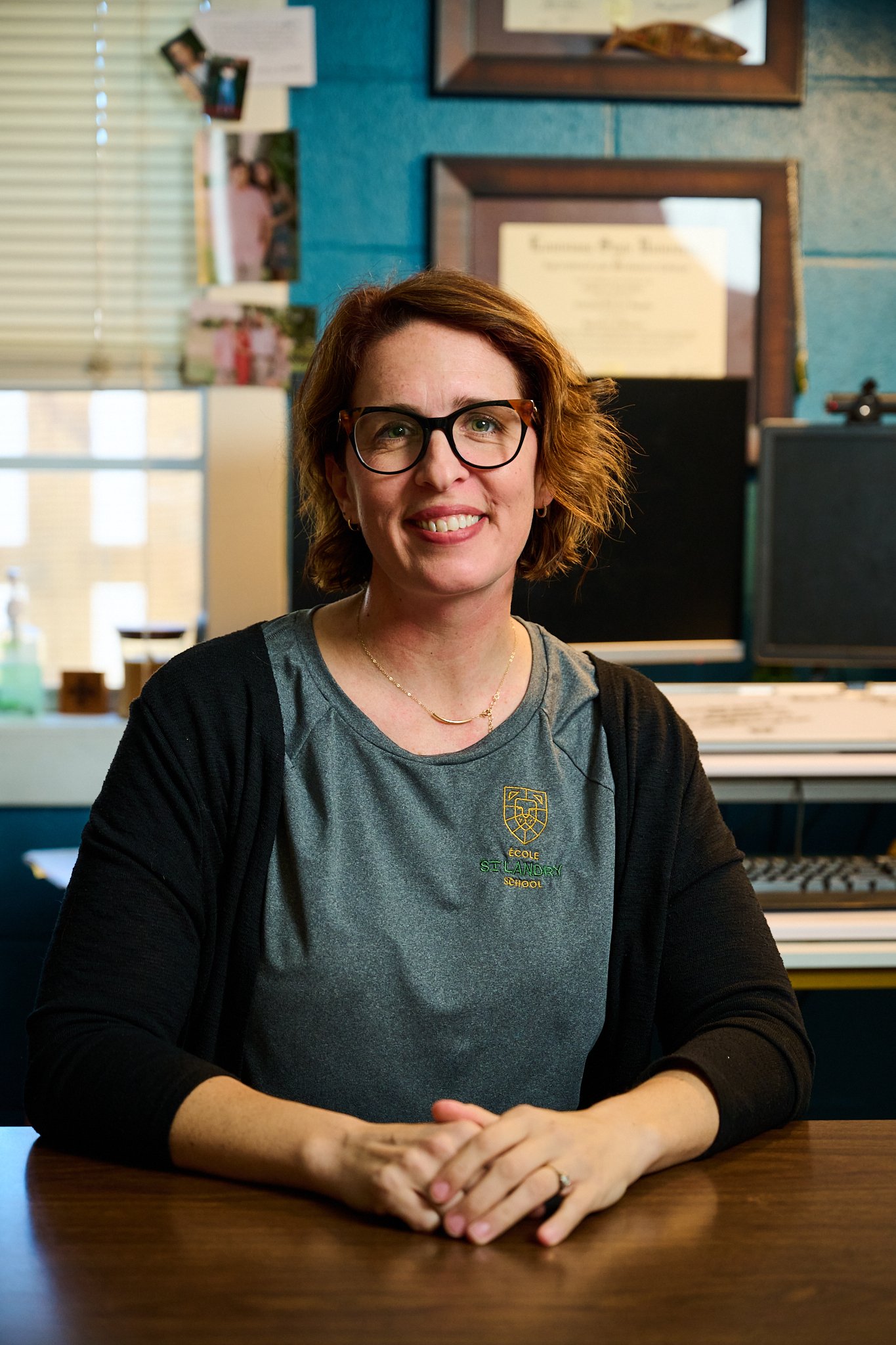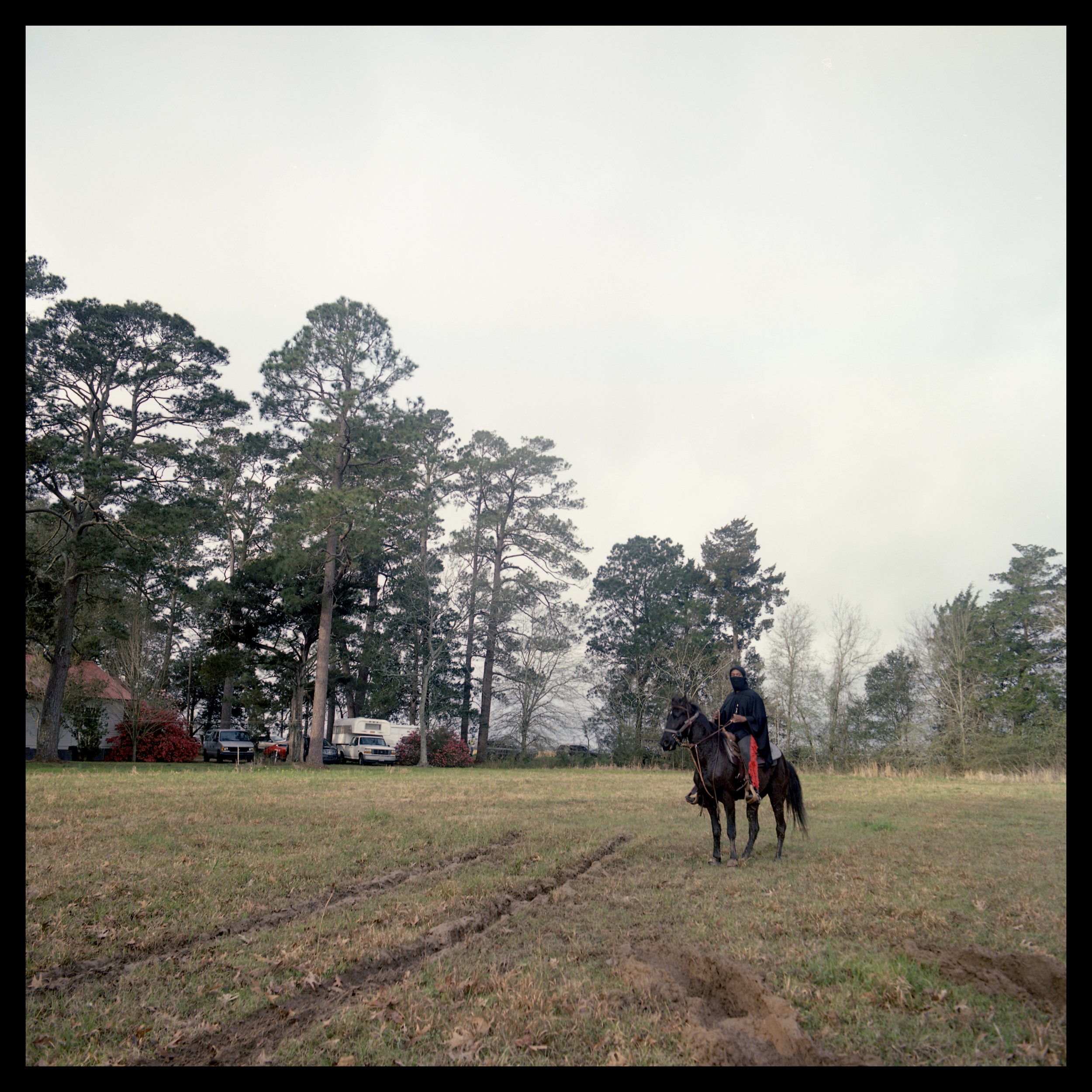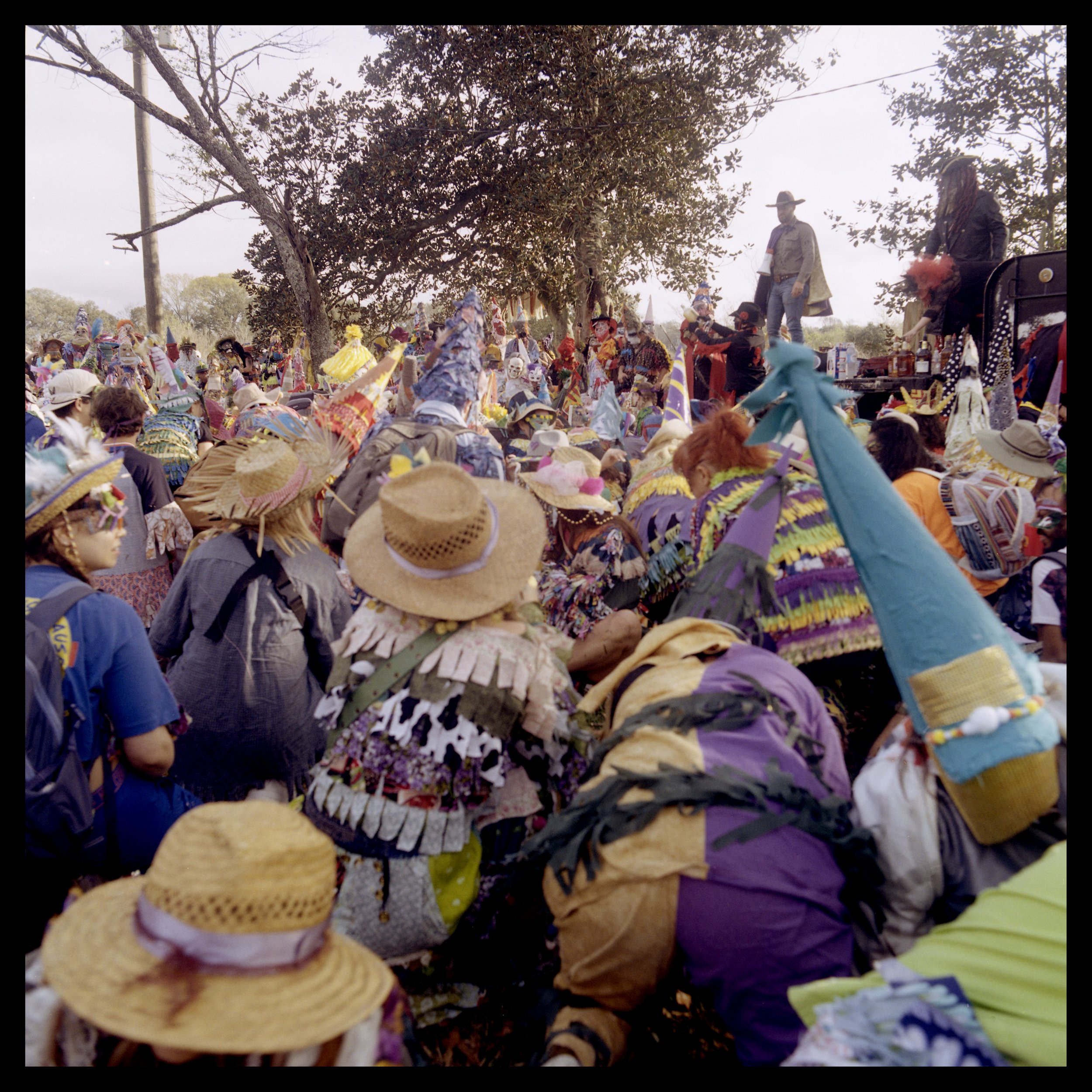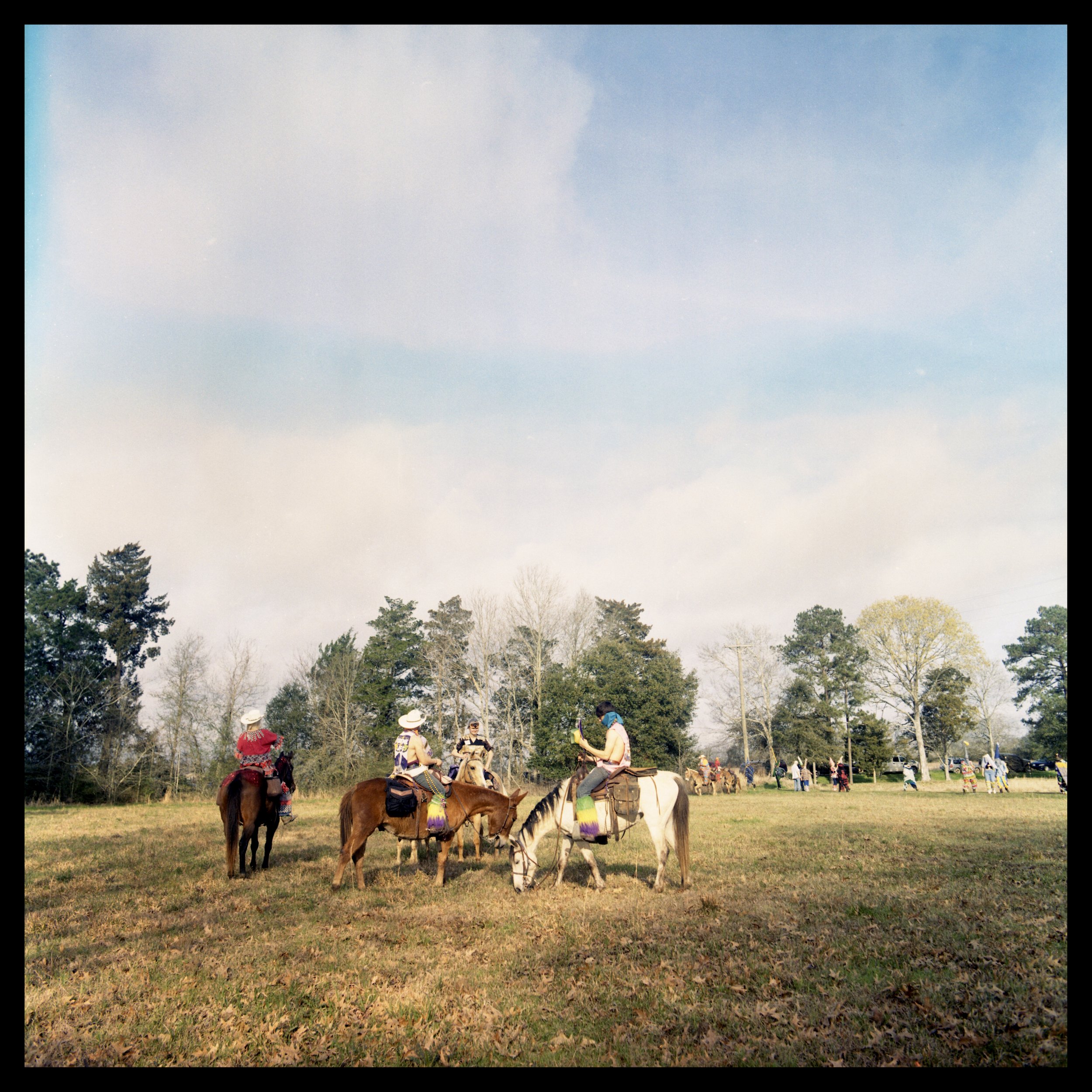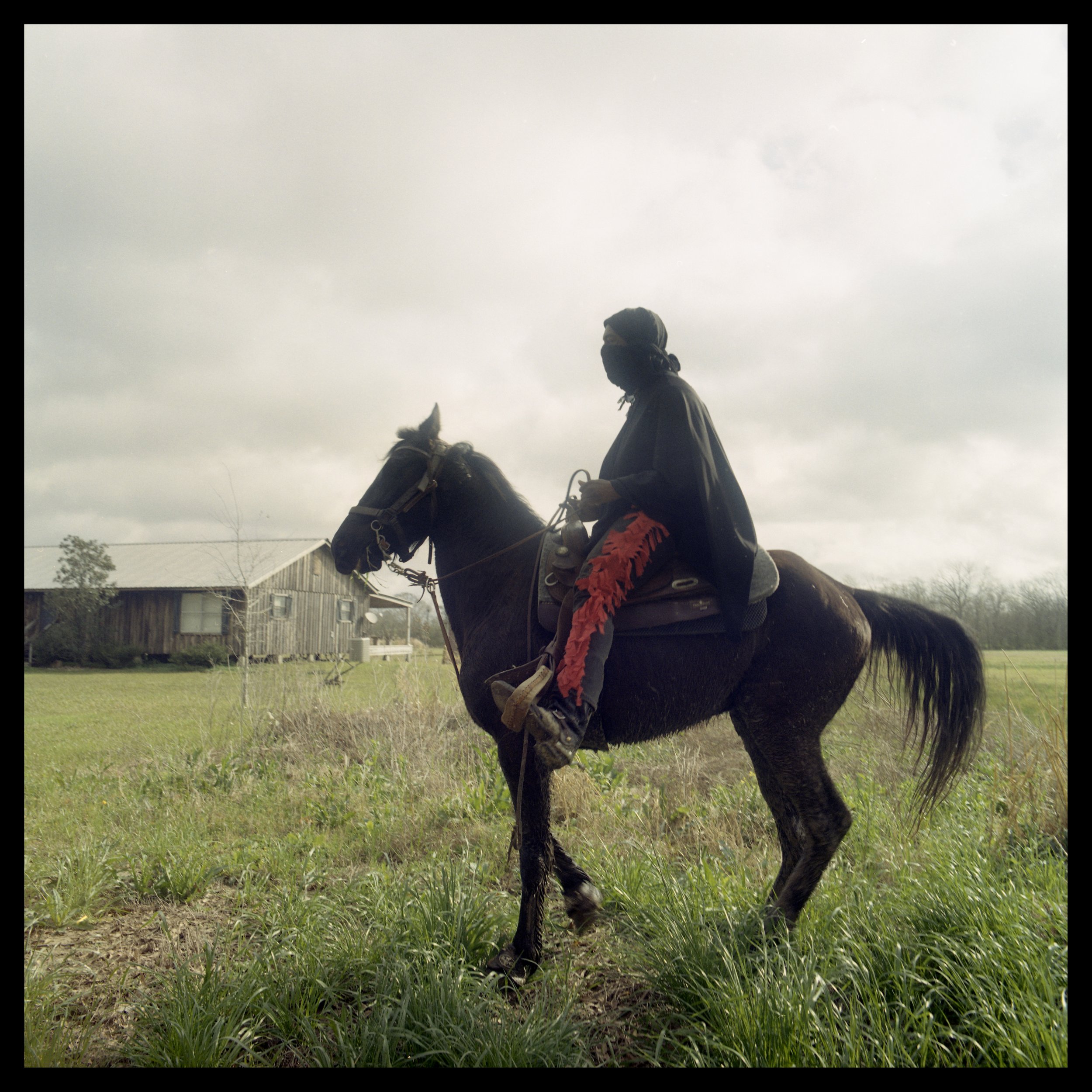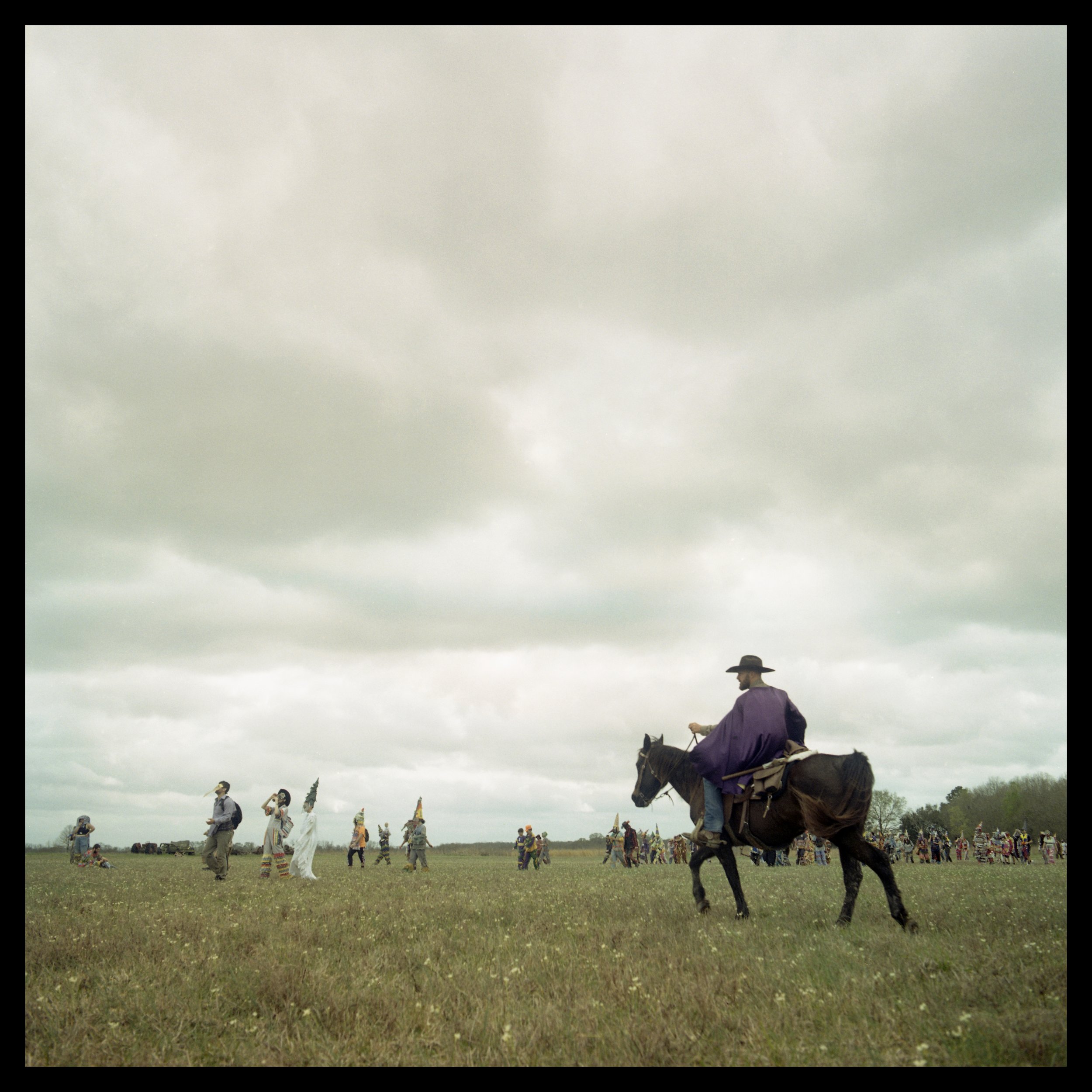Pointe-au-Chien Indian Tribe buys community’s former elementary school
After a lawsuit with the Terrebonne Parish School Board, the Tribe purchased the former Pointe-aux-Chênes Elementary building to serve as a home for École Pointe-au-Chien.
After a lawsuit with the Terrebonne Parish School Board, the Tribe purchased the former Pointe-aux-Chênes Elementary building to serve as a home for École Pointe-au-Chien.
Pointe-aux-Chênes Elementary School was closed in 2021, but will be renovated and house École Pointe-au-Chien. Drake LeBlanc/Télé-Louisiane
By Jonathan Olivier
On Friday, the Pointe-au-Chien Indian Tribe purchased from the Terrebonne Parish School Board the building that once housed the now shuttered Pointe-aux-Chênes Elementary, according to tribal officials. Officials with the tribe plan to allow the building to be used as the eventual home for École Pointe-au-Chien, a new French immersion school that opened in August.
Patty Ferguson Bohnee, a tribal member and attorney for the Pointe-au-Chien Indian Tribe, noted that the one-dollar sale of the building is believed to be part of a settlement of a two-year federal legal battle between the School Board and parents of the former elementary school. Officials with the Terrebonne Parish School Board voted to close Pointe-aux-Chênes Elementary–with one of the highest Indigenous student populations in the state–in April 2021, despite pleas from the community and state officials like Lt. Gov. Billy Nungesser and Speaker Pro Tempore Tanner Magee to allow the school to remain open as a revamped French immersion program.
A lawsuit initiated by 12 parents from the tribe in June 2021 alleged that, by closing the school and refusing, the school board had violated the Civil Rights Act, as well as the 14th Amendment of the Constitution and Article 1 of the Louisiana Constitution, by discriminating on the basis of language and thus national origin against American Indian and Cajun students in the community. In addition, the parents alleged, the school board had failed to adhere to the requirements of Louisiana’s Immersion School Choice Act.
After a year of public outcry from members of the Pointe-au-Chien Indian Tribe, as well as numerous activists and French-language stakeholders, the Louisiana Legislature voted unanimously in spring 2022 to fund and open École Pointe-au-Chien as a public state special school similar to the New Orleans Center for the Creative Arts (NOCCA). The school has an independent board, separate from Terrebonne Parish School Board, whose members were appointed by the Native Tribes of the bayou region of Southeastern Louisiana as well state officials, including the Gov. John Bel Edwards. It now serves as the first French immersion program in Terrebonne Parish.
"It is historic news that our Tribe now owns the school building where so many of our Tribal members and ancestors were prohibited from enrolling and later punished for speaking our heritage Indian French language,” Ferguson Bonhee said. “We look forward to making the building available as a final home for École Pointe-au-Chien upon its reconstruction and know it will continue to be a pillar for keeping the French language and culture of our Indian and Cajun community alive for generations."
École Pointe-au-Chien is temporarily housed at the Vision Christian Center in Bourg, offering grades kindergarten and first. School officials said the program will eventually move to the Knights of Columbus building down the road in Pointe-aux-Chênes while the former school is renovated. Each year, officials plan to add a grade, eventually offering up to the 5th grade. Renovations on the Pointe-aux-Chênes Elementary buildings are expected to take two years, after which point the property will become the homebase for École Pointe-au-Chien
“This is truly a historic day in the fight for Louisiana’s endangered coast, culture, and French language,” said Will McGrew, École Pointe-au-Chien Board President and Télé-Louisiane CEO. “So many people said it would be impossible to open a Bayou French immersion school in PAC. Now we know that not only will we have the school the community has fought for, it will also be housed on Tribal land.”
McGrew added, “In addition to the Tribe's leadership, this victory could not have happened without Jimmy Domengeaux, the parents’ determined pro bono lawyer and the nephew of CODOFIL founder James Domengeaux.”
Leaders reflect on Nathalie Beras’ impact on Louisiana in wake of her departure
Beras, the former consul general of France in Louisiana, stepped down from her role in early August. Local leaders expressed that her impact will be felt for years.
Beras, the former consul general of France in Louisiana, stepped down from her role in early August. Local leaders expressed that her impact will be felt for years.
Nathalie Beras in the coastal wetlands of Louisiana with Albert Naquin, traditional chief of the Jean Charles Choctaw Nation. Courtesy image by Audoin de Vergnette
By Jonathan Olivier
It was September 2021 and Nathalie Beras, the new consul general of France in Louisiana, had just arrived in the state to start her term in New Orleans. Then, Hurricane Ida struck, causing power outages across the Crescent City.
Beras and her staff decided to spend the next two weeks in Lafayette where they worked with local officials to get to know the Acadiana region. Dave Domingue, director of international trade and development at the Lafayette International Center, worked with Beras in that period and noted that her impact on the region’s francophone community was immediately clear.
In one of the first meetings Beras held with Domingue and other francophone leaders of Lafayette, she recommended that the University of Louisiana at Lafayette join the Agence Universitaire de la Francophonie (AUF). “No one at the meeting had ever heard of that,” Domingue said. “So, the university jumped on the opportunity.”
At the end of 2022, the AUF officially approved UL’s membership, which is the first American university to be a member of the Montreal-based network of global universities with francophone concentrations. By the time Beras had gone with her staff back to New Orleans, Domingue said she had left an indelible mark. She had visited smaller francophone communities around Lafayette, like Arnaudville, and showed a genuine interest in understanding the region’s unique challenges and assets—something not all past consuls have done extensively.
“She's given the francophone community here a lot of validation and a lot of recognition,” Domingue said.
Beras stepped down as consul general in early August, leaving behind a legacy that has been characterized by state and francophone leaders as sincere efforts to venture outside of New Orleans and interact with the bulk of Louisiana’s francophone community, which is often found in smaller towns or throughout the countryside of south central and southwest part of the state. From early on, Beras was impacted by the welcome she received in these communities, as well as the widespread attachment to the French language.
"I met the warmest people in these communities that immediately welcomed me into their midst,” Beras said. “I was able to measure the extent to which the French-speaking world is at the very heart of this region, and is enjoying a wonderful renaissance here that is inspired by music and its oral traditions.”
In particular, Beras was supportive of the efforts by south Louisiana’s Indigenous people who often comprise the largest concentrations of French speakers in the state.
“Nathalie has been very supportive of the Tribe,” said Patty Ferguson, a tribal member and attorney for the Pointe-au-Chien Indian Tribe. “She has basically made the effort to go into the communities and be part of these communities, while recognizing the dialects of the other French speakers in Louisiana.”
Beras at a meeting for the opening of École Pointe-au-Chien in 2023. Photo courtesy of Audoin de Vergnette
Beras worked with the Pointe-au-Chien Indian Tribe to highlight their needs as they rebuilt from Hurricane Ida, as well as during their fight to establish the first Indigenous French immersion school in the state, which opened in August, called École Pointe-au-Chien.
“She didn’t just come and do a tour,” Ferguson said. “She has been very active with the community and has invited us to different events. She made sure our leaders were on the list when President Macron came out to New Orleans. Our chairman was able to shake the hand of the French president—that’s pretty huge.”
Among Beras’ other notable contributions to increasing Louisiana’s visibility in la Francophonie was the December 2022 visit from President Emmanuel Macron, which was the first visit from a French President to Louisiana in almost 50 years. In the leadup to the tour, she played a critical role in convincing the president and his team to visit Louisiana, as well as coordinating all aspects of Macron’s visit.
Bears also assisted Gov. John Bel Edwards as he twice visited France, and she negotiated the creation of a delegation of Louisianans that included Edwards to attend the“Fête de la Musique” at the Elysée Presidential Palace in June. Edwards’ visit was the first in 40 years by a Louisiana governor, with francophone Gov. Edwin Edwards being the last to visit the Élysée in 1984.
“I want to thank Consul General Nathalie Beras for her historic work supporting the French language in Louisiana while developing unprecedented economic and cultural partnerships between Louisiana and France,” Edwards said. “I was particularly proud to work with her to welcome President Macron to Louisiana—a first in almost 50 years—and to create a position for a French energy and environmental advisor within my administration. We are sad to see her go, but I am confident her impact will continue for years to come.”
In New Orleans and the surrounding coastal region, Beras was able to see first-hand the impacts of climate change and land loss. She therefore made it a priority to assist Louisiana’s francophone communities who are often at the front lines of these climate issues. Specifically, she facilitated the signature of a first-in-its-kind agreement between the governor and French Foreign Minister Catherine Colonna to fund the creation of a French energy and environmental expert role within the Louisiana government.
Beras coordinated many aspects of President Emmanuel Macron’s visit to Louisiana in December 2022. Photo courtesy of Audoin de Vergnette
The expert, Emmanuel Henriet, arrived in Louisiana in early August just before Beras’ departure, and he will be housed within the state’s Coastal Protection and Restoration Agency (CPRA), also working with Louisiana Economic Development (LED). Louisiana’s closer relationship with France in this domain could lead the state to adopt a bolder energy and climate strategy that opens up economic opportunities for Louisianans.
Beras also worked closely with immersion programs, especially those certified by the Agency for French Teaching Abroad. Tiguida Mathieu, Chief Academic Officer of Lycée Français de la Nouvelle-Orléans, the first such public French program in the United States, noted that Beras was an instrumental partner to further developing the school’s mission.
"The Lycée Français has benefited from the Consul General's deep commitment to education and her commitment to equality and equity,” Mathieu said. “She took a great interest in the Lycée Français because it's a school that embraces diversity. In other words, it's a diverse school where all the children of Louisiana—Black, white, Hispanic, from all walks of life—come together. And that's something Nathalie Beras has supported and developed a great deal.
Beras noted that the key to progress in Louisiana is the growth of French speakers, a unique asset in the state. "Louisiana's youth is energetic and combative, and the determination of these young people in universities and immersion schools is remarkable,” she said.
“I have only one word to say to everyone in my farewell: lâche pas!”
Télé-Louisiane CCO Drake LeBlanc receives 2023 French Culture Film Grant
LeBlanc and producer Rachel Nederveld’s film, “Footwork,” explores Creole trail riding culture in south Louisiana.
LeBlanc and producer Rachel Nederveld’s film, “Footwork,” explores Creole trail riding culture in south Louisiana.
Drake LeBlanc (right) will receive $25,000 as the winner of the 2023 French Culture Film Grant. Drake LeBlanc/Télé-Louisiane
By Jonathan Olivier
This year’s $25,000 French Culture Film Grant from #CreateLouisiana has been awarded to Footwork, a film that explores the Creole trail riding culture of south Louisiana. Drake LeBlanc, the film’s director as well as chief creative officer and co-founder of Télé-Louisiane, and producer Rachel Nederveld, provide an abstract portrait of Creoles in Louisiana, as well as their strong connection to horses.
“I cannot imagine a more deserving filmmaker to receive support from #CreateLouisiana and its partners,” Nederveld said of LeBlanc. “We’re so grateful for their partnership in making this intimate portrait of Drake’s Creole roots and trail riding.”
LeBlanc, who has been working on the project for several months, will continue collecting and compiling footage for the film’s premiere at the 2024 French Film Festival, which will be held in March 2024 in partnership with the New Orleans Film Society.
“I’m excited to have support in making this documentary that will bring Louisiana’s culture to the rest of the world,” LeBlanc said.
The grant aims to support films made in Louisiana that showcase francophone culture in partnership with TV5Monde USA. This year, the grant also has additional support from the Louisiana Economic Development’s Entertainment Development Fund. Other supporters include Cox Communications, Deep South Studios, and the Council for the Development of French in Louisiana.
“TV5MONDE USA has an unshakable commitment to both the community of Louisiana and to showcasing unique stories about the local francophone culture,” said Patrice Courtaban, TV5MONDE USA CEO. “We are thrilled to celebrate the newest #CreateLouisiana French Culture Film Grant winner, Footwork, as they join an illustrious group of filmmakers who have made an impact on not only their community but the greater North American French speaking community.”
As the grant recipient, the film may also be broadcast on TV5MONDE USA, and it will be a part of the “Enseigner Le Français” lesson plan available on the French company’s website, serving as a resource for students around the world.
“#CreateLouisiana is thrilled to offer this unique grant opportunity again this year,” said Scott Niemeyer, #CreateLouisiana founder. “Each year, applicants statewide show us a diverse array of stories depicting Louisiana’s past and present ties to the French language and francophone cultures. We are committed in our efforts to support Louisiana creatives, and the successful continuation of the French Culture Film Grant is a great example of that commitment.”
Colby LeJeune joins KRVS as new host of ‘Bonjour Louisiane’
LeJeune began his role in late July with plans to dedicate air time to French tables, Cajun jams and interviews with Louisiana francophones.
LeJeune began his role in late July with plans to dedicate air time to French tables, Cajun jams and interviews with Louisiana francophones.
Colby LeJeune is live Monday through Friday, from 5 a.m. to 7 a.m., at Cypress Lake Studios on the campus of the University of Louisiana at Lafayette. Cheryl Devall/KRVS
By Jonathan Olivier
Like most people his age, Colby LeJeune didn’t grow up speaking French. Rather, the language was scattered here or there in his English through various words—such as bouder or envie. As is common for many people in the region, the folks in his small community of L’Anse LeJeune in Acadia Parish speak a dialect of English that is strongly influenced by French in terms of inflection, too.
“I was raised with an English that was influenced a lot by French,” said LeJeune, 25. “That helped a lot to already have acquired the sounds of Louisiana French.”
He studied linguistics at Tulane University, but only really started learning Louisiana French in his early 20s. In addition to using books and YouTube videos, LeJeune began venturing to French tables a few years ago. His francophone family members had already passed, so these informal gatherings gave him the opportunity to hear native speakers while practicing his growing vocabulary, too.
“For just about everyone, it’s the only way to learn Louisiana French if you don’t have someone in your family who speaks it or who you can speak with,” he said. “The French tables are specifically for speaking French. The people who come are ready to talk and they want to speak French. It’s all of the ingredients in a single place.”
LeJeune, who is also a master’s student in the French department at the University of Louisiana at Lafayette, stepped into his new role on KRVS' morning program “Bonjour Louisiane” in late July. The show, hosted entirely in French, has a format which has typically been dedicated to broadcasting Cajun and Zydeco music. While LeJeune said he plans to still dedicate much air time to the region’s music, he plans to visit the many French tables around Lafayette in order to document these conversations. He feels that these outings will provide the audience with a way to hear the area’s various accents and the colorful expressions of Louisiana French.
Cheryl Devall/KRVS
In the studio, LeJeune said he also plans to conduct live interviews with musicians and members of the francophone community. He’ll also record jam sessions that take place around Lafayette, such as the Wednesday night Cajun jam at Blue Moon Saloon. LeJeune said he plans to also continue transmitting the sort of cultural information that former host, Ashlee Wilson, featured during her tenure.
“I’d really like to continue what Ashlee had been doing, providing all of the various folklore information, and the stories behind the songs,” he said.
Wilson took over Bonjour Louisiane in September 2022 when Joseph “Pete” Bergeron retired after having hosted the program for 41 years. General manager of KRVS, Cheryl Devall, noted the value of LeJeune’s commitment to continuing this legacy of honoring the area’s culture and heritage languages.
“Around Lafayette I've crossed paths with Colby at Cajun jam sessions, and he's a regular at multiple French tables,” Devall said. “He brings great energy and enthusiasm to his new role with Bonjour Louisiane, and I'm really pleased that he's taken it on.”
For LeJeune, the program will continue to serve as a way to broadcast French to Louisianans who might have few other outlets to hear the language—from older native speakers to younger people wishing to hear what French sounds like in the state.
“If I didn’t have a radio, I wouldn’t have heard French in my everyday life,” he said. “It was thanks to stations like KRVS and KBON. It was a way to hear French every day.”
Bonjour Louisiane is live Monday to Friday, from 5 a.m. to 7 a.m. on 88.7 FM, or online at krvs.org.
Louisiana Sues FEMA Over Rising Flood Insurance Costs
State officials claim the changes to federal flood insurance policy will raise premiums tenfold without taking into account flood protection systems like Morganza-to-the-Gulf.
State officials claim the changes to federal flood insurance policy will raise premiums tenfold without taking into account flood protection systems like Morganza-to-the-Gulf.
Insurance rates are climbing in Louisiana while old suggestions, such as elevating homes, no longer suffice to qualify for affordable coverage. Will McGrew/Télé-Louisiane
By Baley Champagne
Louisiana sued FEMA on June 1 in response to the federal agency’s new system that it uses to calculate flood insurance premiums. Included in the suit are 43 parishes, nine states, local governments and levee districts.
Local leaders argue FEMA’s National Flood Insurance Policy’s (NFIP) Risk Rating 2.0, which was unveiled two years ago to make premiums more equitable, is actually working to raise prices for many Louisianans–in some cases tenfold–while forcing residents to drop coverage altogether. Louisiana Attorney General Jeff Landry, who unveiled the suit, called this federal policy a “natural disaster” of its own. "We believe there are legal deficiencies in these poor decisions, and we intend to hold these bureaucrats accountable,” Landry said in a news release.
In Terrebonne and Lafourche parishes, where the Morganza-to-the-Gulf Hurricane Protection System of locks, levees and floodgates spanning 98 miles will protect 150,000 coastal residents, Windell Curole said insurance premiums will rise drastically. Curole, who is the executive secretary of the South Lafourche Levee District (SLLD), said his NFIP premium for his home in Lafourche Parish is under $500. Under Risk Rating 2.0, he said it will increase to $7,000 annually.
NFIP's method once followed general insurance practices by evaluating a location by its flood zone and on a Flood Insurance Rate Map (FIRM), occupancy type, and the Base Flood Evaluation (BFE). John Gregoire of Grand Caillou, who has been a State Farm customer for nearly two decades, said he pays under $300 for flood insurance for his home. "The insurance company told us to go up three feet higher, and we went six feet higher," he said.
Two raised houses in south Louisiana, which survived Hurricane Ida in 2021. Will McGrew/Télé-Louisiane
Ricky Alstos, branch manager of Riviere Insurance Agency in Thibodaux, said that suggestions like this, before Risk Rating 2.0, would save policyholders hundreds of dollars, but not anymore. Alstos noted that Risk Rating 2.0 considers how close one is to the Gulf and how big the house is. The policy also considers the individual flood risk or the cost to rebuild, according to the Congressional Research Service Reports."I am very passionate about this, but if Louisianans want insurance companies to be here, they have to be willing to pay, and not as before,” he said. “The insurance companies were handing out money instead of preparing for the chance of flood hazards."
Rep. Timothy Kerner, Sr., R-Jefferson, who supported HCR 58, which requests Louisiana’s attorney general to seek legal relief against FEMA, said in 2022 he authored HCR 84 that recommended Congress review and reform the new NFIP. "Risk Rating 2.0 is hurting so many people with premium increases,” he said. “FEMA has not been transparent with the methodology, and what we know does not make sense." Kerner added that FEMA is rating homes in south Louisiana by the distance to a body of water but instead, it needs to consider homes that are protected by a 16-foot flood wall, and many homes are raised 12 feet above sea level.
Kerner continued: ”The lawsuit is because FEMA is considering storm surge, rainfall, distance to the water and cost to rebuild. While excluding factors that should be considered such as stricter building codes, levee protection and elevation of homes.”
In South Lafourche, Curole, who has overseen the levee district's projects for over forty years in various capacities, said his district's flood protection and drainage systems are not prone to regular flooding. “We experience an average of 60 inches of rainfall, tidal water and hurricane surge on an annual basis, even as it lies near the Intercoastal Waterway, Bayou Lafourche and its proximity to the Gulf of Mexico."
The historically strong flood protection system in South Lafourche has not exceeded Risk Rating 2.0's expectations, even after it protected all of the district's residential homes and businesses during Hurricane Ida. "That is a 100 percent reduction in hurricane storm-surge flooding between 1985 and 2021," Curole said. “The lack of transparency harms the South Lafourche Levee District’s ability to partner with FEMA and other federal agencies as its Risk Rating 2.0 harms us by devaluing the significant capital investment the levee district has made."
Nungesser, Local Officials See Opportunity in Saints France Expansion
Leaders in state and local government view the Saints-France partnership as a potential boon for Louisiana.
Leaders in state and local government view the Saints-France partnership as a potential boon for Louisiana.
Saints staff raised the French flag in front of their headquarters after announcing the France-Saints partnership in May. Wayan Barre/Télé-Louisiane
By Jonathan Olivier
In May, the New Orleans Saints announced a market expansion to France that seeks to grow partnerships between the two francophone regions. While concrete details are yet to be announced on what those connections will look like, local leaders are already planning for Louisiana’s increased visibility in the French-speaking world.
“This is no doubt a new chapter in our bilateral relations to promote Louisiana in France,” said Nathalie Beras, consul general of France in Louisiana. “Not only will this opportunity increase our trade, but we can also hope that it will attract more French investors, projects, tourists and talent here.”
This partnership is a part of the NFL’s Global Markets Program, which launched last year as part of an effort to encourage its U.S. football teams to engage fans around the world. The Saints’ French expansion is the team’s first entry into the program as well as the first time France has been chosen as a target market. Compared with other NFL teams, the Saints expansion is especially practical given the region’s historical ties to France, said Ed Verdin, public relations director for the Franklin city government.
“It not only becomes about introducing an international audience with football but, unlike any other NFL team, this will highlight the culture, people, food and music that has deep roots in France,” Verdin said.
Harahan Mayor Tim Baudier echoed a similar sentiment that this cultural connection differentiates Louisiana from other states and, thanks to the new partnership, it’s something that his town can build on. In particular, Baudier sees the partnership as a catalyst for developing a stronger intergovernmental and economic relationship between France and all of Louisiana. For instance, he said there could be a direct flight between New Orleans and Paris, more university partnerships, funding for more French immersion programs, and even the opportunity for Louisiana to have a more involved role in the Organisation internationale de la Francophonie (OIF).
In the meantime, Baudier said that Harahan is beginning its own francophone initiatives. “We are partnering with Alliance Française de La Nouvelle-Orléans to learn the language,” he said. “We’re developing sister city alliances with cities in Quebec and France, incorporating bilingual signage where practical as part of our wayfinding sign program, and exploring a K-12 French immersion program here in town.”
Francophone tourists have long been an important piece of Louisiana’s economy—they make up a large percentage of the visitors to Louisiana each year. Lieutenant Governor Billy Nungesser sees the partnership as a chance to provide another avenue for these tourists to come to Louisiana.
“With Louisiana’s historical connection to France, the granting of the New Orleans Saints international marketing rights in France is another opportunity to bring awareness of what our great state has to offer to an international market,” Nungesser said.
Hitachi
How the rice cooker became a staple of Acadiana food culture.
How the rice cooker became a staple of Acadiana food culture.
The Hitachi rice cooker arrived in Louisiana in the late 1960s. Since then, it has become a staple in Cajun and Creole kitchens. Photo provided by Lucius Fontenot
By Jordan LaHaye Fontenot | Country Roads Magazine
This article was published in partnership with Country Roads Magazine. Read this article and more at countryroadsmagazine.com.
It was the early 1970s, at noon on a Thursday or a Friday. Housewives across Acadiana were preparing lunch, little kitchen TVs turned to Channel 10—Bill Bessun’s typical greeting, “Hi, Bill Bessun here, you’re watching Meet Your Neighbor Acadiana" playing in the background. Looking up from the pot or the oven or the sink, they saw something curious on the television screen: a squat little machine, and a hand scooping rice into it. The camera then zoomed out, focusing again on Bill—who was proceeding as usual. “Hm,” they mumbled, stirring and scrubbing away. The show went on, every now and then panning back to the odd pot of rice, which had started to steam.
Finally, about halfway through the show, Bill looked at the camera and smiled. “Now, if y’all were wondering what we were doing when the show started …”—the camera zoomed back in on the machine—“what we’re doing is making perfect rice. In a Hitachi rice cooker!” At this, someone lifted the lid and reached in with a spoon, pulling out a fluffy, steaming pile of medium grain rice. “You can now get one of these for yourself at Floyd’s Record Shop over in Ville Platte.”
“And the phones never stopped ringing after that,” Floyd Soileau remembers of the most successful advertising campaign of his career. “The ladies were sold on it.”
The Hitachi Rice Cooker's Arrival in America
The mid-century Japanese invention had already risen as a symbol of women’s liberation half a world away—after a Toshiba washing machine salesman discovered that washing clothes was less trouble for Japanese women than the task of preparing three rice-based meals a day. When the salesman proposed the idea of an automatic rice cooker to an engineer, who did not know how to cook rice, the engineer’s wife Fumiko Minami set herself to the task—developing the model still at the base of the appliance almost a century later. During the first year, Toshiba sold 200,000 rice cookers a month. A manufacturer’s race ensued, in which companies across Asia rushed to create their own prototypes. One of those was Hitachi.
By 1958, Hitachi rice cookers had made their way across the Pacific to Hawaii—whose Asian-influenced cuisine also heavily incorporates rice. The trend slowly stretched its way to California—one of the earliest mainland advertisements for the appliance (promoted as being sold at a local Asian market) appearing in the Stockton Evening and Sunday Record in 1966.
“It’s interesting, the idea that the mention of this appliance throughout South Louisiana, would cause people to get really nostalgic and go into these really sentimental stories. People remember that thing very fondly . . . there’s a respect for it—sort of this weird adoration for this artifact.” - Lucius Fontenot
At the time, Americans who encountered the rare machine considered it a foreign novelty more than a revolutionary tool. Hitachi had bigger fish to fry in the American market than a rice cooker—and was devoting more time and advertising money towards their automotive, electronic, and computer products.
But somehow, in the years between 1966 and 1970, the Hitachi rice cooker made its way to Acadiana, where hundreds of miles of fields were freshly a-wave with the products of the still-emerging rice farming industry, and where the regional diet was largely made up of rice dishes like gumbo, jambalaya, étouffée, boudin, and daily plates of rice-and-gravy.
There is more than one origin story attempting to explain the Hitachi rice cooker’s arrival in Acadiana, all difficult to verify with certainty. But newspaper archives show that a Lafayette Asian market called Tomiko’s was placing advertisements for the product in the Daily Advertiser in 1970, selling it as a machine (priced at $26.50) that “Cooks perfect rice every time—automatically—and STAYS HOT AS LONG AS YOU WANT!” At the same time, regular advertisements in the Alexandria Town Talk were promoting them in the classifieds at a price of $19.95, and with a choice of colors.
It was around this time that two Evangeline Parish businessmen, totally independently, encountered the product that, in their hands, would come to revolutionize Cajun and Creole cooking.
Guillory Wholesale
It is difficult to pinpoint exactly when Bruce Guillory and his wife Gladys, owners of Guillory Wholesale in Mamou, first started selling the Hitachi rice cookers. In an article published in 2000 in the Ville Platte Gazette, Gladys cites the date as the mid-1970s. Their son Paul estimated the late 1960s or early 1970s—which is likely more accurate; a Gazette article from November 1971 announces that Guillory Wholesale donated “one of those fabulous Hatachi [sic] 8-cup electric rice cookers” to the Mamou Volunteer Fire Department for their Christmas party raffle.
Regardless, according to Paul, Bruce first encountered the rice cookers at a trade show—likely in Chicago or Dallas. “As I recall, he initially purchased four rice cookers to try—one for my mom, one for his mom, one for Gladys Mayeux, and one for Hazel Deshotels (his two sisters),” he said. “All were pleased with their performance, and he then started selling them like hotcakes.”
“They couldn’t believe the amount of—‘steamers’ they called them—that we were selling. They came here to thank us for that. They had to air freight them into Louisiana. They never expected that. They didn’t know what the hell was going on.” - Floyd Soileau
Arthur Courville, who worked as a delivery man for Guillory Wholesale for fifteen years, remembers the first sale—“We retailed it for $13 a piece,” he said. “And the store made a profit.” It started slow, he recalled. But then “Before you knew something, we were delivering them by the case to the mom-and-pop stores in the country” from Crowley and Basile to Marksville. Once a week, Bruce would go to Lafayette and sell there—“he’s the one that really started pushing the rice cookers in the Lafayette area, too. He really sold a lot, and then it started expanding. I mean, it got to where we were selling … it was unreal what we were selling.”
In the 2000 Gazette article, Gladys explained that the product succeeded because the local people approved of it. The quality was still there, and it was less trouble for the cook.
Floyd’s Record Shop
Around the same time, Ville Platte record producer Floyd Soileau was working directly with Hitachi, selling their stereos, tape recorders, and televisions. (Again, the dates are difficult to verify with certainty, but the earliest Floyd’s Hitachi rice cooker newspaper ad I could find is from 1972.)
Through the grapevine, he learned that Hitachi had another product that might appeal to local cooks. “I had never heard of that before,” he said. He had one of his employees purchase one, and brought it back home to his wife, Jinver. He asked her if she would try to use it to cook the rice for the next day’s lunch.
“So, next day, I’m anxious to get home for lunch, and she’s all disappointed,” he recalled. “She says, ‘Oh, the baby’s crying. I didn’t have time to read the instructions, and I couldn’t do it.” The next day, though, when Soileau came home for lunch, “she had a smile from ear to ear.” She loved it, and described the rice as “perfect”. “That’s all I wanted to know,” said Soileau.
Back at the office, he placed an order from Hitachi for six or seven cases of the rice cookers in various colors and sizes. “We started selling,” he said. “I was trying to get my record dealers to stock it and sell it, but I knew we’d have to do something to let the people know about it.” Thus, the ad spot on Meet Your Neighbor—plus plenty more. Soileau saw the gap between the product and the market—which was basic knowledge of its capabilities—and he spent hundreds of dollars getting the word out. It wouldn’t be an exaggeration to say that the cultural place the Hitachi rice cooker holds in Acadiana today can in large part be attributed to this very advertising campaign. “Nobody had done any promotion,” he said. “The other distributors didn’t want to spend money advertising somebody else’s product. But we were getting orders in-store. We were making money off of this.”
There were other rice cookers, Soileau laughed. “But nobody wanted the Panasonic, because nobody had tried them before. The Hitachi was a proven thing, we approved it. And so, we had the market for it. It was a beautiful set up.”
“The Item to Have in a Cajun Home”
Throughout the 1970s, the Hitachi rice cooker became a coveted newfangled addition to almost every Cajun or Creole kitchen. “Before the rice cooker,” explained Soileau, “Cajun brides had to learn to cook rice in this special little pot on the stove, and you had to use it every day, and get the measurements just right, and cook it just right so you wouldn’t ruin it.” At the 2000 Festival de Musique Acadienne in Lafayette, which was dedicated to Soileau for his contributions to recording and promoting Louisiana French music, Barry Ancelet introduced him as “a young man that probably saved more Cajun marriages than anybody else we can think of”. As it had in Japan, the rice cooker condensed an hours-long process into a few minutes and a single push of a button—granting women more time to spend outside of the kitchen. “The Hitachi rice cooker was the number one gift for newlyweds, at the top of every registry,” said Soileau. “It was the item to have in a Cajun home.”
For a time, the two main distributors of the product in Louisiana were in fact Floyd’s Record Shop and Guillory Wholesale—who were each selling the things by the truckload. The often-repeated oral history claims that the sales reached such monumental heights as to make Louisiana, and Evangeline Parish specifically, the site of the single largest distribution of Hitachi rice cookers outside of Asia. Per local lore, to better understand this phenomenon, executives from Hitachi Corporation in Japan flew to Evangeline Parish to see it for themselves. “They visited Ville Platte and Mamou and all that, thanking us for selling their product,” said Soileau. “They couldn’t believe the amount of—‘steamers’ they called them—that we were selling. They came here to thank us for that. They had to air freight them into Louisiana. They never expected that. They didn’t know what the hell was going on.”
Paul Guillory confirms this, recalling that the executives were actually attending a trade show in New Orleans, and had rented a car to visit Evangeline Parish to figure out why this tiny rural area had such a fierce demand for the cookers. Of course, when they drove the roads leading into Evangeline, the seemingly-infinite fields of rice would have delivered as quick an answer as any. Photographs from Paul’s family archive document the executives’ meeting with his parents, Bruce and Gladys seated with the suited Japanese men at their kitchen table right at the center of a quintessentially 70s-style kitchen, sipping coffee.
The Louisiana market purportedly had its role in the appliance’s evolution, as well. Paul and Soileau each recall that a change to the product was suggested to manufacturers that would make it less reactive to the amount of salt Louisianans tended to add to their rice. “We told them to change that,” said Soileau, “and they did.”
And then there was the matter of size. Originally the cookers came in three-cup, five-cup, and eight-cup options. “We needed a ten-cup,” said Soileau. “And then later they came up with even larger ones for restaurants.”
Eventually, the area's big box stores got wind of the product’s popularity, and Hitachi rice cookers became available everywhere. Guillory Wholesale kept a healthy stock going at the small shops across the region, but Soileau—frustrated that Hitachi was going to stop using him as a main distributor and sell directly to the department stores—quit selling them. “I spent all this money helping you get this program set up, and now you’re going to cut me out? Nah, that was it,” he said.
By that point, though, the Hitachi rice cookers had become a ubiquitous part of the landscape. People could hardly remember cooking rice any other way.
The Enduring Legacy
In 2023, Hitachi still sells rice cookers, but these robot-esque multi-setting $100+ products are rarely found in Acadiana, and hardly resemble their predecessors at all.
Still, the idea of the rice cooker as a kitchen necessity has not dwindled here. When I went off to college, I purchased my own three-cupper and packed it up with my toaster and my microwave. Rice is still a staple in Acadiana’s small towns, and this is how you cook it.
And even I, born at the end of the millennium, know exactly what a 1970s Hitachi rice cooker looks like, and I can place it on my grandmother’s counter—from which we served ourselves so many gumbos and gravies. And like most of the others, still steaming in Cajun and Creole kitchens for miles ‘round, it still works just fine.
“It’s one of those things where, as an adult, it’s like—wait how do I get one of those?” said Mamou-raised, Lafayette-based photographer and filmmaker Lucius Fontenot. “They’re always around.”
Inspired after inheriting his grandmother’s avocado green cooker and photographing it, Fontenot found himself drawn into the enduring legacy of the cooker—discovering how many people he knew still had them and had intense memories associated with them. “It’s interesting, the idea that the mention of this appliance throughout South Louisiana, would cause people to get really nostalgic and go into these really sentimental stories. People remember that thing very fondly . . . there’s a respect for it—sort of this weird adoration for this artifact.”
His ongoing Hitachi Rice Cooker project features photographs of cookers still in operation in kitchens across Acadiana, combined with interviews of their current owners—altogether forming a tapestry of Acadiana’s culinary history centered around this little Japanese invention, which is now as thoroughly Louisianan as corner store boudin, or gravy on rice.
"It was like the dinner bell—‘Come serve yourself a plate!’ —Kirstie Cornell
"My cooker has been with me for more than thirty years—it outlasted my marriage, and has fed me in a way that goes beyond bringing rice to the table. —Sarah Spell
"In the back shed, we found two Hitachi rice makers, still in the boxes. I said, ‘That’s mine!’ I think we kept the other one in the box just in case someone’s breaks or dies. The other brands of rice cookers just don’t work right. They don’t have the ‘ding!’" —Rachel DeCuir
“I mean,” laughed Fontenot, “when I was a kid, I thought Hitachi was a French word.
Gov. Edwards Meets President Macron at Concert During Economic Development Trip
The two men spoke several times at the “Fête de la Musique” at the French Presidential Palace in Paris. The event was headlined by Jon Batiste, a first for a Louisiana musician.
The two men spoke several times at the “Fête de la Musique” at the French Presidential Palace in Paris. The event was headlined by Jon Batiste, a first for a Louisiana musician.
Edwards and Macron spoke during the Fête de la Musique held on June 21 in Paris. Will McGrew/Télé-Louisiane
By Jonathan Olivier
Louisiana Gov. John Bel Edwards again met with French President Emmanuel Macron during the annual “Fête de la Musique,” hosted at the Élysée Palace in Paris on June 21. The two leaders last met in December when Macron visited New Orleans, the first from a French president in almost 50 years.
Edwards made a last minute decision to attend the Fête de la Musique at the invitation of Macron to continue their conversation on increasing economic investment and cultural partnership between France and Louisiana.
Edwards arrived in Europe on June 16 to meet with business and health sciences leaders from around Louisiana to “explore future business development and expansion opportunities with prospective and current international partners and top executives of major global corporations, focusing on the energy, aerospace and life sciences sectors,” according to a statement from his office. Some of the companies on Edwards’ list include Boeing, Airbus, and Air Liquide, a French gas company with a presence in Louisiana.
“Diversification is the key to prosperity and continued growth in our increasingly interconnected global economy,” Edwards said. “Louisiana’s economy is more diverse than at any time in our state’s history, but there is more work to be done. The global shift toward sustainability has created surging demand for low-carbon energy. NASA’s Artemis mission has launched a new era of space exploration. Technological advances have emboldened a new generation of life sciences innovators. The result of all these developments is the same: rapid transformation of emerging sectors in Louisiana, and a historic opportunity for economic growth.”
During the concert, New Orleans jazz musician Jon Batiste played for a second time for Macron–he first performed for the French president at a White House state dinner. Batiste’s performance was the first time a Louisiana musician headlined the Elysée edition of the Fête de la Musique, an important spotlight for the state. Also with Batiste were New Orleans musicians Herlin Riley, Mitchell Play, James Andrews and Mahmoud Chouki, as well as French-Lebanese trumpet player and composer Ibrahim Maalouf.
French President Emmanuel Macron addresed the crowed at the Fête de la Musique, before a performance by New Orleans and Lebanese musicians. Will McGrew/Télé-Louisiane
In addition to playing French classics, Batiste started off the night with the French national anthem, which the crowd sang along to. He closed out the night with a rendition of “When the Saints Go Marching In,” a likely homage to the New Orleans Saints’ recently announced expansion to France. The French President joined Batiste and his fellow musicians in a second line through the crowd at the conclusion of the night.
A delegation of Louisianans also attended the concert, including Télé-Louisiane CEO Will McGrew and CCO Drake LeBlanc, musician Jourdan Thibodeaux, the Consulate General of France in New Orleans Nathalie Beras, Historic New Orleans Collection CEO Daniel Hammer, and New Orleans Jazz Museum Executive Director Greg Lambousy
McGrew said that the presence of Louisiana musicians, politicians, the governor, and business leaders displays that Louisiana is taking its place in the francophone world.
“At Télé-Louisiane, we are working on several promising projects with France, particularly in our media field,” McGrew said. “To strengthen these long-term partnerships, we need more of our own Louisianans and Louisiana institutions that put the interests of the Louisiana people at the heart of their actions.”
Edwards and his wife Donna at the Fête de la Musique with Drake LeBlanc and Will McGrew of Télé-Louisiane (left), as well as the Consul General of France in Louisiana Nathalie Beras (right). Will McGrew/Télé-Louisiane
McGrew is in France for a series of business meetings with the predominant French media outlets including France Télévisions, France Médias Monde, and TV5Monde, and he met briefly with French Presidential Advisor Emmanuel Bonne and French Minister of Culture Rima Abdul-Malak, who expressed support for cultural and media partnerships along these lines.
A rising star in Cajun and Creole music in Louisiana, Thibodeaux spoke with Macron, who recognized him from his trip to New Orleans. Thibodeaux shared with the French president his hope that our endangered French language can be the bedrock of Louisiana-France ties going forward.
“The President thanked me for being there, and I thanked him for having me,” Thibodeaux said. “I’m proud I was invited and that Louisiana was represented at the Palace. I hope a Cajun or Creole musician who speaks French can return to play a concert there, too.”
Efforts Continue for Increased Coastal Revenue After Partial Win in Debt Ceiling Bill
The debt ceiling bill includes changes to federal law after an effort by local leaders, which will facilitate coastal restoration without increasing Louisiana’s share of offshore revenues.
The debt ceiling bill includes changes to federal law after an effort by local leaders, which will facilitate coastal restoration without increasing Louisiana’s share of offshore revenues.
Rep. Garret Graves, R-Baton Rouge, and Speaker of the House Kevin McCarthy, R-CA, meet with a bipartisan group of leaders from Louisiana in March to discuss the BREEZE Act. Will McGrew/Télé-Louisiane
By Jonathan Olivier
After weeks of negotiations between President Joe Biden and House Republicans, an effort led by Rep. Garret Graves, R-Baton Rouge, the Fiscal Responsibility Act was passed on June 3 to avoid a historic default on U.S. debt obligations. The bill also includes provisions that will work to speed up projects to protect Louisiana’s coast.
In addition to avoiding a financial crisis, the bill includes changes to the 1970s-era National Environmental Policy Act, or NEPA, which requires federal agencies to examine how large-scale projects will impact the environment, an approval process that can often take years. The bill narrows the scope of these reviews by placing a two-year limit on them without reducing any environmental requirements.
NEPA was created at a time when Louisiana’s coastal crisis wasn’t as advanced as it is today. Therefore, these updates to federal policy will allow the Coastal Protection and Restoration Authority (CPRA) to more efficiently tackle large-scale projects that involve some initial environmental impacts in the quest to actually protect and enhance coastal ecosystems, such as the Mid-Barataria Sediment Diversion.
“NEPA’s process has slowed down major ecosystem restoration projects because it was written with different assumptions about projects in mind,” said Neal McMillin, director of federal affairs for the Office of the Governor’s Coastal Activities division. “By allowing federal agencies to finally consider the cost of doing nothing, and to make decisions in a more timely manner, the NEPA reforms in the Fiscal Responsibility Act will allow the coastal program to better restore Louisiana’s coastal wetlands in a major way.”
The bill also clarifies and reinforces that shared revenues from offshore energy production are treated akin to state funds rather than federal, and this designation allows flexibility which can help to increase efficiency in executing coastal restoration or flood control projects. While this change is a partial win for local leaders, a bipartisan push to increase Louisiana’s share of offshore energy revenues continues.
Private companies pay the federal government fees and royalties in order to drill offshore. Through the Gulf of Mexico Energy Security Act (GOMESA), 37.5 percent of this funding is shared among the four oil producing states of the Gulf Coast: Louisiana, Alabama, Mississippi and Texas. These funds go toward coastal restoration projects, and local leaders would like this share to be increased to 50 percent—the level allocated to other states where oil and gas production occurs on land.
Garret Graves, R-Baton Rouge, discusses increased offshore revenue for Louisiana at the Capitol in March. Will McGrew/Télé-Louisiane
During previous negotiations, the Republican plan to raise the debt ceiling by $1.5 trillion called the “Limit, Save, Grow Act,” or H.R. 2811, contained an energy package that would have increased this shared revenue to 50 percent. House Republicans included in H.R. 2811 a previous bill dubbed H.R. 1 that was passed in March on a vote of 225-204, which included the text from the Budgeting for Renewable Electrical Energy Zone Earnings, or BREEZE Act, sponsored by House Majority Leader Steve Scalise, R-Jefferson, and Troy Carter, D-New Orleans. In addition to increasing revenue sharing from 37.5 percent to 50 percent, the BREEZE Act would also remove the $375 million cap on revenues transferred by the federal treasury to states and begin revenue sharing for offshore wind production.
Graves noted in an email that H.R. 1 is a critical piece of legislation for the future of Louisiana’s coastline. “Not only will this bill increase our domestic energy production, but it will also increase the resiliency funding our state and parish governments receive from energy development,” he said. “These local resiliency projects will drive down flood insurance rates, strengthen our region’s economic and ecological resiliency, and reduce federal disaster costs. This is a win-win-win that will protect our state’s communities, people, languages, culture, and our way of life.”
U.S. Senate Majority Leader Chuck Schumer, D-N.Y., called H.R. 1–a broad piece of legislation that includes a variety of energy-related provisions– “dead on arrival,” while the White House released a statement charging that the bill rolls back investments in clean energy made by Democrats.
Without increased revenue sharing, Louisiana will continue to lose out on billions from offshore energy leases compared to states that primarily produce onshore, which already receive a 50 percent share. If no further action is taken, Louisiana will also receive no revenue-sharing funds from its nascent offshore wind industry. Thanks to the debt ceiling deal, the increased revenue would all be considered state revenue and continue to be split between the state of Louisiana and its coastal parishes.
“The BREEZE Act levels the playing field for Louisiana and other coastal states, who deserve a fair share of the revenues generated from energy produced off our shores,” said Chip Kline, the chairman of the state’s Coastal Protection and Restoration Authority (CPRA). “Disasters like the Deepwater Horizon Oil Spill cannot continue to be our main source of funding for coastal projects. The revenue sharing improvements in the BREEZE Act would provide an additional $3.1 billion to Louisiana’s coastal program over the next decade, which is critical revenue that will help us continue implementing large-scale, transformational projects for decades to come.”
While H.R. 1 was passed on a party line vote, the BREEZE Act provision has broad, bipartisan support in Louisiana, including Governor John Bel Edwards. In March, a bipartisan coalition of economic and political leaders from Louisiana, including local governments and the CPRA, met with congressional leaders at the U.S. Capitol to express the importance of increased investment in Louisiana’s coastal crisis.
Matt Jewell, parish president of St. Charles Parish, was part of the group and said in an email that the bill has the potential to unleash American energy production, while further investing in efforts to protect the state’s coastline.
“Southeast Louisiana relies on funding made available through our offshore energy production to fund critical projects to restore and rebuild our vanishing coast,” Jewell said.
New Orleans Musician Jon Batiste to Headline Louisiana Soirée at French Presidential Palace
French President Emmanuel Macron invited Batiste to take part in the event, part of the “Fête de la Musique,” which takes place in France each summer.
French President Emmanuel Macron invited Batiste to take part in the event, part of the “Fête de la Musique,” which takes place in France each summer.
Jon Batiste at the New Orleans Jazz Fest. Jessica Link/Télé-Louisiane
By Jonathan Olivier
New Orleans Jazz musician Jon Batiste will perform at the Élysée Palace, the official residence of the president of France in Paris, leading a delegation of Louisiana musicians and leaders who are a part of the "Fête de la Musique."
During his visit to New Orleans in December, President Emmanuel Macron invited Louisiana to participate as the guest of honor at his garden party, which will highlight the ties between Louisiana and France. Batiste will play with Ibrahim Maalouf, a French-Lebanese trumpet player, producer and composer, as well as New Orleans-based jazz legends Herlin Riley, Mitchell Player and Mahmoud Chouki.
“We are thrilled that Louisiana has been invited by President Macron for this unique event” said Nathalie Beras, consul general of France in Louisiana. “In the speech he gave during his visit last December, he expressed his desire to include the State in France's future initiatives in favor of Francophonie, such as the forthcoming Cité Internationale de la Langue française in Villers-Cotterêts. This Fête de la Musique is a strong sign of our deep cooperation in many areas, including music, of course, and I'd like to thank Greg Lambousy, Executive Director of the New Orleans Jazz Museum, for his help putting together this exceptional group of New Orleans talent.”
The festival was founded in 1982 as an event where people are invited to play music outside, such as in public spaces or their neighborhoods. New Orleans Jazz Museum Executive Director Greg Lambousy noted that with this invitation, France and Macron are shining a light on the rich culture of New Orleans. “Music and cinema are intertwined,” he said. “Jon Batiste will perform with iconic New Orleans musicians Herlin Riley, Mitchell Player and Gallatin Street Records artist, Mahmoud Choucki, helping to strengthen ties between the two cities in music and film production.”
Meet the People Building a Bilingual Economy in Louisiana
Across Louisiana, there are businesses supporting a French and Creole-speaking economy by offering jobs to locals and catering to tourists from France, Canada, and beyond.
Across Louisiana, there are businesses supporting a French and Creole-speaking economy by offering jobs to locals and catering to tourists from France, Canada, and beyond.
Bryan Dupree co-founded Beausoleil Books in 2020 in order to bridge Louisiana’s culture and those throughout the world. Jonathan Olivier/Télé-Louisiane
This article is Part 3 in a series on French in Louisiana. Part 1, which explains the complexities of French immersion in Louisiana, is available here. Part 2, which explores how former immersion students are creating a French environment in Louisiana, is available here.
By Jonathan Olivier
It was a simple stroll through downtown Lafayette in 2020 that convinced Bryan Dupree and his husband James Colvin to open an independent bookstore. The couple had walked by a group of French tourists who were looking for a place to buy a postcard and have some wine, with service in French.
At the time, Lafayette didn’t have a local bookstore—something that Dupree, who has a degree in French literature, thought was badly needed. Service in French, although available at a few establishments, also wasn’t always easy to find. So, Dupree and Colvin, along with two friends, opened Beausoleil Books in October 2020 to meet both of those needs.
“The idea was that French people from abroad could come and learn about French culture in Louisiana and Louisiana French speakers could learn about the breadth of French that is abroad,” Dupree said. “So, my idea was that we would have a French section that would showcase Louisiana French authors, which it does. And then also showcase new and rising talent in francophone countries around the world, which we do.”
Dupree curates this French book section, called “Le coin francophone,” which promotes this sort of cultural exchange through literature that he said opens up the world to the various groups of francophones—local and from abroad—in Lafayette.
In addition to French-speaking employees, Beausoleil includes bilingual signage and a curated section of books in French. Jonathan Olivier/Télé-Louisiane
At Beausoleil, there are often a myriad of French events like poetry readings and book presentations by French-speaking authors. Beausoleil is usually staffed by at least one francophone who either works in the bookstore or the adjacent Whisper Room, which is a bar.
“I think it's important to provide an opportunity where people can use their French practically,” Dupree said. “That opportunity was given to me to speak in French and be paid to do it when I was a tour guide at Laura Plantation. And I would like to give that opportunity to more people, too.”
Building a Diversified Economy
In 2021, the West Baton Rouge Museum in Port Allen rebranded with a specific focus on highlighting French and Louisiana Creole in partnership with Télé-Louisiane. Angelique Bergeron, the director at the museum who speaks French and Louisiana Creole, said they have trilingual and bilingual signs across the museum grounds. Museum guides, like André St. Romain, offer tours in French. The museum also hosts French-speaking events, such as the Café Français that takes place once a month.
“We just wanted to create a space where people could come together, speak the languages, celebrate the languages and culture, and also come and find work or do something in the languages,” Bergeron said.
Bergeron noted that businesses that offer services in French work toward two goals: to cater to the large numbers of French-speaking tourists that come to Louisiana each year, and also to offer opportunities to local francophones. “My kid is in French immersion in first grade,” she said. “We’ve got a ways to go, but hopefully there'll be jobs for her in French when she gets older.”
André St. Romain is one of the francophone employees at West Baton Rouge Parish Museum, who is capable of giving tours to visitors in French. Ethan Castille/Télé-Louisiane
Bergeron pointed to efforts such as French immersion programs that are creating a pool of francophones that will eventually be looking for work. Bergeron said the upside to hiring Louisiana francophones is that, at the museum, her staff is also capable of catering to the influx of tourists from France and Canada.
According to the Louisiana Department of Culture, Recreation and Tourism, in 2021 the travel and tourism industry was Louisiana’s fifth highest employer, and France and Canada often top the list of travelers. Due to Louisiana tourism advertisements that target francophone visitors, French-speaking tourists are often expecting services in French, yet they are often disappointed at the lack of them, according to Lawson Ota who owns Tours by Marguerite in New Orleans.
Lawson, who offers tours in English, French and Creole, is an advocate for investing more in institutionalizing Louisiana’s heritage languages—hiring francophones or creolophones at restaurants, hotels, hospitals and more. For him, this will only attract more tourists to grow an already powerful economic force. But, he said, getting there will require hard work.
“If we want this industry to grow and for Louisiana French and Louisiana Creole to have futures, the government must understand that it’s not only an opportunity to make money,” he said. “It’s necessary to work and to make investments.”
There are some initiatives that invest in the Louisiana francophone business sector. Télé-Louisiane created full-time jobs for francophones in media and journalism through support from the state legislature and governor. Additionally, there are a handful of workforce training initiatives such as a newly created scholarship offered by the Council for the Development of French in Louisiana (CODOFIL) for a Louisianan to attend a business immersion program at HEC Montreal, a business school within the University of Montreal.
CODOFIL also offers scholarships for young professionals to attend the Université Sainte-Anne in Nova Scotia, Canada. The University of Louisiana at Lafayette is planning to offer a certificate in business French in coordination with the Paris Île-de-France Regional Chamber of Commerce and Industry.
A bilingual sign at the West Baton Rouge Parish Museum. Ethan Castille/Télé-Louisiane
There is no active, wider effort within the state government to enhance Louisiana’s francophone business sector. This is despite the laws passed in the early 2010’s, such as Act 679 and Act 106, that specifically tasked state agencies with enhancing Louisiana’s business and tourism sector in regards to French.
For Ken Douet, who co-owns Maison Stéphanie bed and breakfast between Arnaudville and Cecilia with his husband Richard Howes, strengthening Louisiana’s multilingual economy starts with children enrolled in immersion. Douet said he and Howe work to assist Teche Elementary in Cecilia with various projects. At the end of the year, Maison Stéphanie will host an event with Brandon and Aurore Ballengée, a nearby francophone family who founded the annual Atelier de la Nature. These sorts of connections are crucial, Douet said, to display to children that French exists outside the classroom.
“I think that for them, it’s only a language,” he said. “It’s still not a part of their culture. By getting out of the classroom and into everyday life, you have the chance to have experiences in the language and with music, food, games. And it’s there that the language becomes a true part of yourself, not just in the classroom.”
Douet pointed out that, in certain communities in Louisiana, there already exist ample businesses who employ francophones or creolophones, but likely don’t advertise it. For instance, in Arnaudville, only a few miles from his business, Douet said there are native French or Creole speakers at practically all of the local establishments—Myran’s Maison de Manger, Russell’s Food Center, Bayou Teche Brewery, NUNU Art and Culture Collective and The Little Big Cup. By making the effort to highlight these employees further and hiring more of them, Douet said the community can continue to nurture Louisiana’s heritage languages.
“You start to talk with people and you realize that there are still a lot of people who speak French,” he said. “But if you don’t make the effort, you don’t know who speaks French.”
NOLA Zydeco Fest to Honor Creole Culture
The festival returns in an effort to bring together the Creoles of southwest Louisiana and those of New Orleans.
The festival returns in an effort to bring together the Creoles of southwest Louisiana and those of New Orleans.
The NOLA Zydeco Fest returns this June to bring together the Creole people of Louisiana. Photo courtesy of NOLA Zydeco Fest
This article is part of a media partnership between Télé-Louisiane and the NOLA Zydeco Fest.
By Jonathan Olivier
Gabrielle Deculus and Courtney Smith founded the NOLA Zydeco Fest in 2021 to honor the legacy of their great-grandfather, legendary Zydeco musician Alphonse “Bois Sec” Ardoin. The festival also has served as a way to bridge the Creole cultures of New Orleans and the countryside of southwest Louisiana.
This year, festival organizers look to continue to build these relationships by highlighting the unique contributions of Creoles to Louisiana’s history and culture. “This festival serves as a way to showcase both New Orleans culture, which includes brass bands and Mardi Gras Indians and second line groups, along with the trail rides and the more rural Louisiana Creole culture,” Deculus said. “And then there’s the energy that Zydeco music brings. We wanted to create a lane for both of those cultures to co-exist and have a better rapport.”
This year, the festival returns to A.L. Davis Park in New Orleans on June 10 to continue celebrating Louisiana’s Creole people and culture. Musical performances will include Lil Nathan and the Zydeco Big Timers, Koray Broussard and The Zydeco Unit, Rusty Metoyer and the Zydeco Crush, and Alphonse Ardoin and the Zydeco Kings.
Drake LeBlanc, co-founder and chief creative officer of Télé-Louisiane, will be representing Télé-Louisiane at this year’s festival, co-hosting the event along with Deculus and Smith. “Making connections between different cultures has always been an essential part of Louisiana history and it's exactly what we're doing today,” LeBlanc said. “As a co-founder of Télé-Louisiane from southwest Louisiana, I look forward to bringing some of that spice we like to the onstage dynamic at this festival in New Orleans.”
LeBlanc noted that he will be highlighting some of the influences that French and the Louisiana Creole language have had on zydeco music and Louisiana culture as a whole. Louisiana Creole is a creolized language that formed in colonial Louisiana in the 18th century. The language has long co-existed with Louisiana French, spoken by many in bothCajun and Creole communities from New Orleans to Vacherie to Cecilia to New Roads.
NOLA Zydeco Fest is free to enter and open to the public, and Deculus said children are welcome—there will be a dedicated children's activity area. Advance registration is possible, though, which allows participants to skip the entrance line and have the opportunity to win prizes.
For more information about NOLA Zydeco Fest, visit their website.
UL Lafayette Conference Highlights Diversity of French in the Americas
Students and young professionals from North and South America and the Caribbean participated in “Université d’été” that covered topics relevant to French-speakers of the Americas.
Students and young professionals from North and South America and the Caribbean participated in “Université d’été” that covered topics relevant to French-speakers of the Americas.
Joseph Savoie, president of the University of Louisiana at Lafayette, addresses participants at the opening ceremony of “Université d’été” on May 22. Jonathan Olivier/Télé-Louisiane
By Jonathan Olivier
Better understanding the diversity of the French-speaking world of the Americas was the theme of the sixth edition of the “Université d’été sur la francophonie des Amériques,” which was held in Lafayette the final full week of May.
The program, held outside of Canada for the first time, was organized by the University of Louisiana at Lafayette (UL) and the Centre de la francophonie des Amériques (CFA), a Quebec organization that seeks to facilitate relationships between the French-speakers of the Americas. The conference was structured as a course offering 45 credits, which was composed of 50 participants—30 from Canada and 20 from the rest of the Americas, including the United States, South America and the Caribbean.
“This program offers a perspective of the francophone communities of the Americas,” said Sylvain Lavoie, CFA president. “It’s a time of training, of exchange, of networking for the students and participants who take part. And also, the program contributes to this link between francophones to discover, to set off on adventure, and to create bridges between the different regions and the different participants.”
Throughout the duration of the program, there was a focus on la francophonie, a term that refers to the French-speaking community, either globally or locally. This conference, specifically, focused on la francophonie of the Americas—the issues faced by francophones of the Western Hemisphere who often exist as a linguistic minority. Lafayette served as a fitting place to discuss French as a minority language, given the status of the language in the region.
Guyaume Boulianne, from the francophone region St. Mary’s Bay in Nova Scotia, has been to Louisiana several times to explore the Acadian connection to the region and to play music. This time, he said he was able to explore what la francophonie means for him.
“Our French-speaking community and Louisiana’s are maybe more similar because of our Acadian connection,” he said. “But someone who is from Chile who speaks French, I’m not necessarily convinced that we have a similar identity due to that. But what joins us is the French speaking community.”
The overlying theme of the program was this diversity of la francophonie in the Americas—and the participants were encouraged to explore these connections further. It was a chance for francophones to interact with other French-speakers who, although they may differ culturally, share a common linguistic bond. Justin LeBlanc, director of economic development and tourism for Cap Acadie, New Brunswick, took part in the program in order to better understand who makes up la francophonie of the Americas.
“I really want to understand the issues of the different francophone communities from all over,” he said. “I know that in New Brunswick, we’re the only officially bilingual province of Canada, but we still at times have to fight for our rights as French-speakers. So, it’s really with an open mind that I’m trying to better understand the reality of these people.”
Barry Ancelet, retired professor from the University of Louisiana at Lafayette, recited poetry during the opening ceremony for the “Université d’été” on May 22. Jonathan Olivier/Télé-Louisiane
There was a particular focus on Louisiana and its francophone population, with presentations by Barry Ancelet, Joseph Dunn, Lawson Ota, Christine Verdin and more. Subjects included how climate change is impacting Native American francophone groups, such as the Pointe-au-Chien Indian Tribe and the United Houma Nation, as well as the importance of expression in French for those in a minority language context. Participants also took a field trip to Arnaudville in order to highlight several initiatives based in St. Landry Parish, such as École Saint-Landry and the Saint Luc French Immersion and Cultural Campus.
The program was another high-profile event that displayed the resiliency and importance of Louisiana’s French-speaking community after French President Emmanuel Macron visited the state in December. Nathan Rabalais, associate professor of French and francophone studies at UL, said that Louisiana was a logical choice for this program given the relationship the Center has with the state, local researchers and cultural activists. “The themes of this edition makes UL Lafayette an ideal place to explore these subjects,” he said.
In January, UL Lafayette became the first American university to join the “Agence Universitaire de la Francophonie,” an international network of 1,000 members from 122 countries that encourages cultural and economic development within the French-speaking world. In order to continue to facilitate the relationships, the university is committed to offering more opportunities to grow its presence within la francophonie.
“The Modern Languages Department is working to offer professional French certifications as well as new courses on translation and French business and media courses related to tourist sites and local businesses,” Rabalais said.
New Orleans Saints Expand to France as Team’s First Global Market
The move will allow the Saints to develop commercial and cultural ties between Louisiana and France.
The move will allow the Saints to develop commercial and cultural ties between Louisiana and France.
The Saints’ French expansion is the team’s first entry into the Global Market Program as well as the first time France has been chosen as a target market. Will McGrew/Télé-Lousiaine
By Will McGrew
The New Orleans Saints announced today that the NFL has approved its request to add France as its first international market. The collaboration will allow the football team to develop marketing, fan engagement and commercialization partnerships in the French market.
The NFL launched the Global Markets Program last year as part of an effort to encourage its U.S. football teams to engage fans around the world. The Saints’ French expansion is the team’s first entry into the program as well as the first time France has been chosen as a target market.
"We are excited to be awarded France as our NFL Global Market Program territory," Saints owner Gayle Benson said. "New Orleans and France have enjoyed a unique cultural connection for centuries and we are excited about working with the NFL and our partners in France to grow the game of American football. In addition to having the opportunity to market our team in France, we are looking forward to promoting our city and state and driving investment in local and regional businesses."
This decision expands into the realm of sports the positive momentum that has been taking place in Louisiana’s French speaking ecosystem over the past few years. In particular, last year, the State Legislature authorized the largest budget in history for Louisiana French projects that totaled $4 million–including support for École Pointe-au-Chien and Télé-Louisiane’s programming partnership with Louisiana Public Broadcasting (LPB).
In December, French President Emmanuel Macron visited Louisiana in a historic trip. During the visit, he met with key francophone, political and economic leaders including Saints owner Gayle Benson. Benson also met with the French Ambassador Philippe Etienne in January to discuss collaborations between technical experts on the renovations of Saint Louis and Notre Dame cathedrals as well as the addition of a New Orleans-Paris direct flight on AirFrance.
The Saints raised the French flags with the flags of Louisiana, the US, and the team at their headquarters in Metairie the day of the announcement (May 23, 2023). Will McGrew/Télé-Louisiane
Dunn: Job Creation is Essential to the Louisiana Francophone Movement
State laws already exist that would highlight and strengthen francophone businesses in Louisiana. The next step is to fund and staff them.
State laws already exist that would highlight and strengthen francophone businesses in Louisiana. The next step is to fund and staff them.
Taalib Auguste (right), who speaks English, French, and Louisiana Creole, is a member of a multilingual staff who leads tours at Laura Plantation in Vacherie. Taalib Auguste
By Joseph Dunn
Joseph Dunn served as the executive director of the Council for the Development of French in Louisiana (CODOFIL). He is the director of PR and marketing for Laura Plantation in Vacherie, Louisiana.
At Laura Plantation in Vacherie, Louisiana, tourists from France, Québec and Belgium wait in the gift shop for the 1 p.m. French tour to begin. The historic Creole sugar plantation offers tours en français three times a day:one in the morning and two in the afternoon. When asked if the tour option in the French language influenced his decision to visit, Guillaume, from France, replied, “It’s important to have a tour in French to understand this history. We have this fantasy in France about Louisiana. The way it is presented in ads and on television makes us believe that we will hear at least some people speaking French, but we’ve been here for three days and this is the first place we have spoken French with locals since our arrival.”
Guillaume’s experience is not an exception. It’s the norm for Francophone tourists visiting the state. Géraldine, from Québec, was also recently in Louisiana. Visiting world-renowned museums in New Orleans, she was astonished at the absence of language options. The interpretative panels and digital kiosks are only in English. “Being from Québec, I automatically look for the button that will allow me to view information in French. I’m really surprised that museums in a city with such deep French history don’t take into consideration that not all of their visitors speak or read English.”
Dial 8 for French
Thanks to an automated answering service in Ottawa, Canada’s Lord Elgin Hotel is just one of many businesses that provides the option “composez le 8 pour continuer en français.” In the capital city of a nation where English and French are official languages, it is expected that services, especially in the public and other essential sectors, be equally available in French as in English.
Such a scenario could exist in Louisiana thanks to legislation passed more than a decade ago. In 2010, Act 679 of the Louisiana legislature recreated the Council for the Development of French in Louisiana (CODOFIL), giving the agency specific mandates to oversee the state’s economic development and tourism promotion initiatives in French, as well as to create a certification system to identify festivals, businesses, and other entities that provide services in French. (See CODOFIL’s “Oui!” Initiative).
Act 106, also passed in 2010 and called “The Louisiana French Language Services Program,” mandates that CODOFIL and the Louisiana Department of Recreation, Culture, and Tourism (DCRT) to create a census of each French-speaking state employee in order to :
to the extent practicable, to provide state government services to French- speaking citizens and visitors in the French language
to assist Louisiana citizens who speak French in dealing with and receiving services from the state government so as to support the long-term sustainability of Louisiana's historic French cultural heritage
to assist French-speaking visitors to the state and thus to promote an increase in tourism and greater investment in the state from Francophone countries
The law, modeled after French-language services legislation in Nova Scotia, Canada, also requires the department to “provide for appropriate insignia, such as a badge with the word "Bienvenue" or "Bonjour" to identify employees who will assist French-speaking clients in accessing and using department services.”
Despite this legislation, these important mandates are largely unknown to the Louisiana public and they remain unfunded and thus unstaffed.
It is curious, especially given the popularity of French immersion schools and the publicity they garner from local and international media, that no real pathways have been created to make French “useful” in the Louisiana tourism marketplace or in other professional sectors. This could easily be remedied by the introduction of policies in state and local governments (especially tourism promotion offices) which require the active recruitment and hiring of French speakers from Louisiana.
Jobs in French Equal Economic Development
At Laura Plantation, the site employs two full-time and eight part-time bilingual staff members who ensure the operation of the site, handle social media and public relations, conduct archival research, greet guests, lead tours, and sell merchandise… all in French. These efforts at hiring and training French-speaking staff members, especially young Louisianians eager to use their language skills in a professional setting, along with cultivating the Francophone tourism market, have been fruitful. Francophone visitors accounted for 20 percent of annual visitation in 2022.
French is a natural resource in Louisiana that we simply need to cultivate and develop. At Laura, we offer tours in French and people come for that. It’s not really rocket science.
New Speakers of French in Louisiana: Continuing a Legacy
In Lafayette, former immersion students are establishing the institutions necessary to support a new generation of francophones.
In Lafayette, former immersion students are establishing the institutions necessary to support a new generation of francophones.
In 2021, Stephen Ortego worked with Makemade and Lafayette Consolidated Government to design and implement bilingual signs in downtown Lafayette. Jonathan Olivier/Télé-Louisiane
This article is Part 2 in a series on French in Louisiana. Part 1, which explains the complexities of French immersion in Louisiana, is available here.
By Jonathan Olivier
Renée Reed began learning French when she was around five years old at Evangeline Elementary School, an immersion program in Lafayette. Although she left the program just a year later, French remained in her life through learning Cajun music and spending time with her grandparents who are native speakers of Louisiana French.
“I remember a period in my life when I was little, speaking mostly French at school,” she said. “And then when I’d go to my grandparents, because I’d go to my grandparents a lot, we would speak French.”
Despite Reed’s familial link to French, English was still her mother tongue. Given that English had become the region’s dominant language for a few decades by the time she was growing up in the early 2000s, it was easy for French to take a background role. Then, in high school, she began playing Cajun music with her mom, Lisa Trahan, who plays with the Magnolia Sisters, and her dad, Mitchell Reed, who played with BeauSoleil. Later on, as a student at the University of Louisiana at Lafayette, she majored in French and music.
Due to the various ways Reed had learned the language, she had created a patchwork of French competencies. In order to form a more solid base, in 2019 when she was 20, she participated in a five-week immersion program at the Université Sainte-Anne in Nova Scotia, Canada. Participants could only speak French for the duration of the program, during classes and a variety of workshops, games and extracurricular activities.
“That's where you're really learning is when you're in real life with the language,” said Reed, now 24. “And I had never been in those kinds of situations before. And so, in that experience, I was learning more than I was even processing. By two weeks in, I could really talk and I wasn't even aware of how much I was learning.”
Renée Reed plays with several Cajun music groups in Lafayette, as well as a solo act that allows her to write music in French. Courtesy of Renée Reed.
Reed is what linguists in Europe who study minority and heritage language revitalization call a “new speaker.” Typically, this refers to someone who has had little home or community exposure to a heritage language, and who then acquires it via immersion education or language revitalization projects.
In the last few decades, French has been principally passed down to younger generations of Louisianans like it was for Reed—through immersion education as children or adults. Many native speakers of Louisiana French are often elderly, usually older than 60, yet many more are in their 70’s or 80’s. As this demographic continues to age, in the near future new speakers of French in Louisiana will comprise the bulk of the francophones in the state.
This generation of new speakers, often younger than 40, represents a generational shift that developed after home transmission of French faded in the mid to late 20th century. Their grandparents likely spoke French as a first language, and their parents are likely anglophones with some knowledge of French. This contact with native speakers of Louisiana French, although often limited, gives new speakers the ability to grasp what they can and pass it on, according to Stephen Ortego, a Lafayette-based architect who, as a teenager, also studied at Université Sainte-Anne.
“Our generation is a sort of bridge between our grandparents who almost all spoke French and the next generation,” said Ortego, 39, from Carencro. “It’s up to us to transfer the language to this next generation. And it’s important to have a certain percentage of us who continue what makes us special.”
In order for French to continue to remain viable with this new generation, folklorist and professor emeritus at the University of Louisiana at Lafayette Barry Ancelet wrote in a 1988 essay that there must be the development of a “French environment.” This includes a society where French is institutionalized and visible alongside English, including the existence of radio and television programs, magazines, books, billboards and road signs. “If someone is to bother learning French,” Ancelet wrote, “there must be something worth doing, reading, seeing, and hearing in the language.”
For much of the decades following Ancelet’s call to restore French in the state, his francophone environment failed to gain steam. Yet, in the last few years, there has been a flurry of progress thanks, in large part, to former French immersion students. Scattered about south Louisiana are signs of new life that is nurturing French within the state’s wider society through infrastructure, music and art.
Building a French Environment
Ortego heard French often when he was a kid, spending time in Washington or Opelousas with his French-speaking grandparents, neighbors and extended family. But he wasn’t immersed in a society where French is institutionalized until, at age 19, he attended Université Sainte-Anne’s immersion program. It was there that he began dreaming in French, thinking in French, all without effort. This, Ortego said, provided him with a solid base of the language so that he could return to Louisiana with the linguistic skills to live in French.
“Afterwards, I continued to speak in French with my grandparents, neighbors and friends,” he said. “I made friends my age who were in immersion. I refused to speak in English with people in Louisiana who I knew spoke French because I wanted to learn. It was the only way to learn.”
Only a few years later, Ortego served as a state representative, from 2012 to 2016. During that time, he invested in institutionalizing French in Louisiana. Ortego’s House Bill No. 998 in 2014 allowed parish governing bodies, either police juries or parish councils, to ask the Louisiana Department of Transportation and Development (DOTD) to provide bilingual signs along state and federal highways. The bill was ultimately signed into law by Governor Bobby Jindal, becoming Act 263, which first tasked DOTD with adopting changes to the Manual on Uniform Traffic Control Devices (MUTCD) to include bilingual signage.
Bilingual signs were installed in Lafayette in 2021 thanks to Makemade, SO Studio Architecture and Lafayette Consolidated Government. Photos of signs courtesy of Makemade.
“We had already started talking with several parish presidents or presidents of the police jury in the 22 parishes of Acadiana,” Ortego said. “We had the intention that as soon as the policy was adopted by DOTD, we wanted to go to each parish and talk with the police juries or the parish councils.”
According to Ortego, DOTD never took steps to adopt the changes to the MUTCD. So, nearly 10 years later, local parishes still don’t have the opportunity to adopt bilingual signs. Yet, Ortego made progress on this front in 2021. His firm SO Studio Architecture was able to work with Makemade and Lafayette Consolidated Government to install bilingual wayfinding and street signs throughout downtown, called the Route Lafayette project.
While these signs exist only around downtown Lafayette at the moment, Ortego’s firm and Makemade also took some of the steps that DOTD has not, making changes to the MUTCD that features bilingual signs that go beyond wayfinding, such as stop signs. If the parish government would decide to adopt these changes parish-wide, Ortego said the document outlining changes to the MUTCD would provide a pathway to do so. On the state level, Ortego emphasized that, legislatively, everything is in place for DOTD to expand bilingual signage.
“Maybe there are people who can ask their state representatives to return to this question and push more to maybe provide money to DOTD to adopt the policy that is already written in law,” Ortego said. “So, if it’s financed, there aren’t any more excuses.”
A Bridge to the Next Generation
Philippe Billeaudeaux was part of the first French immersion class in Lafayette in the early ‘90s at S.J. Montgomery Elementary School, which is now housed at Myrtle Place Elementary. Billeaudeaux continued on to Prairie Elementary School and then Paul Breaux Middle School, while he also heard some French at home from his father.
“I have continued using French in my creative projects,” said Billeaudeaux, 37, from Lafayette. “I play Cajun and Creole music with Feufollet, Steve Riley and Cedric Watson. I also do a cartoon in Louisiana French with filmmaker Marshall Woodworth, who lives in New Orleans. We created ‘Les Aventures de Boudini et Ses Amis,’ a cartoon for immersion students.”
Boudini, a project between Billeaudeaux and Woodworth’s Creole Cartoon Company and Télé-Louisiane, first aired online in January 2021. This year, a new season of the series will air on Louisiana Public Broadcasting. With characters voiced by Louisianans like long-time immersion teacher and poet laureate of French Louisiana, Kirby Jambon, and musicians Cedric Watson and Louis Michot, immersion students have the opportunity to hear Louisiana French from within the local francophone community.
Philipe Billeaudeaux (left) and Marshall Woodworth created the cartoon “Les Aventures de Boudini et Ses Amis,” which provides immersion students a way to learn Louisiana French. Courtesy of Philippe Billeaudeaux
In the last few years, there has been an uptick in projects led by former immersion students. In 2018, a podcast called “Charrer-Veiller,” was founded by Joseph Pons and Chase Cormier; Drake LeBlanc, the chief creative officer and co-founder of Télé-Louisiane, and Jo Vidrine, a staff photographer, participated in Lafayette’s immersion schools; and “Le Bourdon de la Louisiane,” an online news journal, was founded in 2018 by former Sainte-Anne student Sydney-Angelle Dupléchin Boudreaux and also Bennett Boyd Anderson III.
Around Lafayette, a few organizations target immersion students in order to provide examples of French existing outside the classroom. At Vermilionville, Lafayette’s living history museum, the staff is again hosting a summer camp in July for French immersion students. Zach Fuselier, a former immersion student, works at Vermilionville as the heritage gardener where he tends to the museum’s animals and garden, offering presentations virtually every day in French.
“Often, we have tourists from Canada and France and other French-speaking countries,” said Fuselier, 26, from Lafayette. “So, I can share my culture with them and I can do it in French. It’s a language that they’re most comfortable in. And I can show them that there are still people who speak French in Louisiana.”
Despite the recent projects of some former immersion students, Fuselier said that the majority of his former classmates likely don’t use the language in their everyday life. Life outside of school often exists solely in English—even for him, English is the language he uses the most in his life. That’s why it’s even more important, he said, to nurture a francophone environment so that immersion students, both current and former, continue to exist in the language after they leave the classroom.
“We’ve got to provide an incentive for children, first to learn the language and second to use it in their everyday life,” he said. “If we want to bring back French, we have to have more resources, just to live in French.”
Developing New Francophones With French Immersion Schools
More than 5,000 children are learning French through immersion in Louisiana, establishing a small but growing population of new francophones across the state.
More than 5,000 children are learning French through immersion in Louisiana, establishing a small but growing population of new francophones across the state.
This article is Part 1 in a series on French in Louisiana. Part 2, which explores how former immersion students are using their language skills to support French in the state, will be published on May 9.
Story by Jonathan Olivier | Photos by Jo Vidrine
In the middle part of the 20th century, home transmission of French began to rapidly decline in Louisiana—what linguists call a “language shift,” as English became the dominant language spoken at home and throughout the state’s communities.
According to 1990 census data, more than 80 percent of self-identified Cajuns born at the turn of the 20th century still spoke French as their first language at home, according to Shane K. Bernard in his book “The Cajuns: Americanization of a People.” That figure fell to 21 percent for those born between 1956 and 1960, and even lower to eight percent for those born between ‘71 and ‘75. “A similarly dismal number spoke French as a second language,” Bernard wrote. While this doesn’t represent all francophone groups in Louisiana, it does offer an idea of the extent of the language shift that occurred in the 20th century.
This trend continued for decades so that, these days, French has essentially disappeared as a first language learned at home or spoken at large throughout communities. Instead, French is now typically learned by monolingual anglophone children as a second language in French immersion schools, where they learn an academic, standard variant of the language. Therefore, immersion has become one of the most important and viable ways to grow a population of new francophones in Louisiana.
“We have kindergartners who are speaking full sentences to us in French by Christmas, telling us what they need,” said Lindsay Smythe, school leader at École Saint-Landry, an immersion charter school in Sunset. “And they can remain and participate in French all day long.”
At École Saint-Landry, children who are typically monolingual anglophones begin in kindergarten where they spend the majority of their day learning in French through courses like math and science. Usually, they are only taught in English during English Language Arts classes.
Founded in 2021 as a full immersion campus with kindergarten and first grade, École Saint-Landry currently houses kindergarten through second grade. Smythe said they’ll continue adding grades as their current group of students progresses each year, eventually offering up to the eighth grade.
In 2010, immersion students totaled 3,416 statewide. Today, the 103 students currently enrolled at École Saint-Landry are among more than 5,100 children who participate in French immersion at more than 35 schools across the state. They have joined the thousands more who have participated in immersion over the last three decades. Several thousand more have participated in immersion programs as adults, most notably at the University Sainte Anne in Nova Scotia, one of the Acadian provinces of Canada.
Yet, immersion is still a niche effort that exists within a wider anglophone education system. Immersion students make up less than one percent of Louisiana’s school-age demographic—there are around 1 million children under 18 in the state. So, growing the number of schools that offer a program has been a priority of language activists and educators for years now.
According to Michèle Braud, world languages specialist at the Louisiana Department of Education, state officials involved with immersion would like to continue expanding enrollment by five percent each year. Although Braud’s department is still compiling numbers from the 2022-2023 academic year, she said enrollment is up.
In August 2023, three more programs will open: École Pointe-au-Chien in Pointe-aux-Chênes will become the first program serving a predominantly Indian French population; Evangeline Reimagine Academy will open in Ville Platte thanks to Louisiana’s Reimagine School Systems Grant; and Fairfield Elementary Magnet School will be the first program in Shreveport.
The Beginning of French Immersion Schools in Louisiana
James Domengeaux, who in 1968 was pivotal to the establishment of the Council for the Development of French in Louisiana (CODOFIL), often said that “L’école a détruit le français; l’école doit le restaurer.” “School destroyed French; school must rebuild it.” Of course, what Domengeaux was referring to is that French in Louisiana experienced such a rapid decline in the 20th century, in part, due to the 1921 state constitution that made English the official language of the classroom. This resulted in French being barred from schools—corporal punishment was often inflicted on children who spoke the only language they knew in order to force them to learn English.
Domengeaux’s vision was to reestablish the language throughout Louisiana’s communities via education. In the 1970s, CODOFIL initially instituted this plan through French language classes for short durations during the school day—the results proved to be unpromising. Domengeaux then looked to Canada, and he learned of experimental yet successful French immersion schools that, instead of teaching students French as a language class, taught them most classes in the language itself. Domengeaux’s interest led to a pilot immersion program in Baton Rouge in 1981. Yet, the programs didn’t really begin to take off until the ‘90s.
In the early 2010’s, CODOFIL’s mission was amended through a series of laws. In 2010, former Senator Eric Lafleur, D-Ville Platte, introduced Act 679, which passed to redefine CODOFIL’s purpose. The agency was specifically tasked with enhancing Louisiana’s French immersion schools in coordination with the Louisiana Department of Education and the Louisiana State Board of Elementary and Secondary Education through the International Associate Teacher Program.
Establishing an immersion program in a Louisiana school district is possible thanks to legislation passed in 2013. Act 361, called the “Immersion School Choice Act,” states that parents or legal guardians of at least 25 pre-school aged children who live in a particular school district need to sign a petition, and state law dictates a school board must create an immersion program. Unfortunately, the law has no enforcement mechanism, and at least four petitions have gone unanswered by local school boards: two in St. Tammany Parish and two Terrebonne Parish. Braud with the LDOE said that the more successful tract to opening a program is for parents to simply begin a conversation with the school district, CODOFIL and LDOE.
Typically, a program is housed within a traditional, English-language school that offers a French immersion tract. Some schools only offer French immersion, such as École Saint-Landry. There are only a handful of options for high schoolers who want to continue in immersion, such as Lycée Français in New Orleans and Lafayette High in Lafayette.
French in an Anglophone Curriculum
Rebuilding French after several generations of language shift hasn’t been an easy task. The lack of home transmission means that Louisiana doesn’t have an adequate pool of francophone educators who are certified. So, CODOFIL and its partner agencies coordinate with foreign governments to provide U.S. Department of State’s J-1 visas to teachers who instruct in Louisiana for a three-year period, which can be extended for two more years. The state has formal agreements for teacher exchanges with France, Canada, and Belgium, and teachers also come from other countries too, increasingly from Francophone Africa.
The reliance of foreign teachers means that students often don’t hear Louisiana French in the classroom, as educators are unaware of its regional variances. The state’s Minimum Foundation Program (MFP) also caps the number of foreign teachers that can instruct in immersion in Louisiana at 300. Therefore, priority is given to elementary programs. The MFP cap, plus high rates of attrition among immersion students post middle school, have led to the creation of only a handful of high school immersion programs.
In order to expand her burgeoning school, Smythe with École Saint-Landry would like to see the state law changed to remove the MFP cap. Because, as of now, expanding her school beyond eighth grade would be a challenge—she’d have to find local teachers who are francophone and certified to teach, which she said can be difficult in small towns like hers.
Foreign teachers are also tasked with navigating Louisiana’s curriculum standards. Each school is subject to its local school district’s curriculum, which is often written in English. “So, if a parish adopts a math curriculum, if that math curriculum does not exist in French, it is on the shoulders of the immersion teachers to translate the entire curriculum into French,” Smythe said.
Smythe said she’d like to see the creation of a state-wide French language arts curriculum that could be applied to all of the French immersion schools. However, some schools, such as Audubon Charter School in New Orleans, follow both Louisiana and French national academic standards, the latter set forth by the French Ministry of Education that is part of Agency for French Teaching Abroad (AEFE).
According to Sophie Capmartin, French program director at Audubon, her students learn using books and materials purchased from France. “The work on a French curriculum allows a greater openness to the world and brings an intercultural perspective on certain themes or in the way of approaching certain disciplines,” Capmartin said. “The texts in French literature are integral works of French-speaking authors that students study as soon as the third grade.”
Capmartin noted that students at Audubon typically score above or on the French national average on the French national exam, which certifies someone’s French language abilities. In general, immersion students tend to perform better on standardized tests than their monolingual peers.
Despite the challenges of reestablishing French within an anglophone educational system, Smythe said she recognizes the many benefits her students are receiving. Plus, she feels she is doing her part in reconnecting her students to a unique linguistic heritage.
“As a French speaking society, I personally feel very honored to be a part of what we’re doing,” Smythe said. “Anybody who is bilingual, they're just going to have more opportunities, they're going to have more doors open. I'm just so pleased that we were able to bring this to our students, because they didn't have that opportunity before, and now they do.”
Tu Vis Ta Culture ou Tu Tues Ta Culture
With his latest album, Jourdan Thibodeaux implores Louisianans to hold on to their heritage.
With his latest album, Jourdan Thibodeaux implores Louisianans to hold on to their heritage.
Jourdan Thibodeaux’s new album, La Prière, was released in March 2023. Drake LeBlanc/Télé-Louisiane
This article was published in partnership with Country Roads Magazine. It is available in print and online here.
By Jonathan Olivier
Last October, Lafayette’s Festivals Acadiens et Créoles closed out Saturday night with a performance by Jourdan Thibodeaux and his band Les Rôdailleurs. The set included hits from Thibodeaux’s 2018 debut album, which has earned him a following at home and afar, as well as a mix of new tunes anchored by his French lyrics.
His last song of the night, also the title from his sophomore album released this spring, La Prière, didn’t conform to typical closers. Instead, it was slow, rhythmic, solemn. The crowd, which had spent the day two stepping and waltzing, turned to the stage in reverence. Many swayed back and forth. Among those who could understand Thibodeaux’s French lyrics, there were even tears.
In the first lines, dubbed over an interview with Thibodeaux’s late grandfather Charles Herbert, he chants: “Tu vis ta culture ou tu tues ta culture, il n’y a pas de milieu.” “You live your culture or you kill your culture, there is no in between.”
In the song, Thibodeaux acknowledges the young Louisianans who cannot understand his lyrics, people who have forgotten Louisiana’s traditions and its language, and those who only speak, as he sang, “la langue de les conquis,” or the language of the conquered—English.
At the core of La Prière, which means “The Prayer,” Thibodeaux invokes that the French language—and the culture that sustained it—will not fade away into history. He prays that people continue to actively participate in Louisiana’s rich cultural heritage. And he prays that his generation won’t be the last to live it.
While La Prière is a somber reminder of how much Americanization has changed Louisiana, it’s also a rallying cry to assemble all the cultural pieces that former generations left behind, in order to preserve and perpetuate the qualities that make Louisiana so unique. This call to action, in large part, is Thibodeaux’s life’s work.
“People are always saying, ‘I’m Cajun’ or ‘I’m Creole.’ And they’re really proud of that,” he said. “But you can’t only have the title. If you want the title, you need to keep everything associated with it. You need to keep the language, the culture, the religion—because it’s all connected.”
Thibodeaux learned French from his grandmother, Lucille “Hazel” Blanchard. In order to pass the language to his two daughters, he speaks French to them at home, ensuring that, in his family, the over-three-hundred-year-old linguistic chain remains unbroken. He sticks to traditions that he was raised with—such as Roman Catholicism, hunting and gardening, and local customs like “pâquer,” which features knocking eggs together in a game played at Easter.
“We need to pass all that we have been given from other people to the next generation,” he said
Jourdan Thibodeaux et Les Rôdailleurs at Festivals Acadiens et Créoles in October 2022. Photo courtesy of David Simpson
La Prière’s original 2020 release was delayed due to COVID-19. Thibodeaux, who plays fiddle and sings, released the album with Eunice’s Valcour Records with his band Jourdan Thibodeaux et Les Rôdailleurs, which he founded in 2018. Today, the band consists of renowned musicians Cedric Watson, Joel Savoy, Alan Lafleur, and Adam Cormier.
While many local artists who sing in French today record remakes of older songs, or stick to traditional notions of what Cajun or Zydeco music should sound like, Thibodeaux writes his own music, on his own terms. His songs are heavy on the fiddle and feature prominently his raspy Louisiana French lyrics. For La Prière, Thibodeaux and his band cut songs from a list of around 40 that he has written over the course of the last several years. “I recorded the songs I feel the most at the moment,” he said.
The resulting album represents snippets of the musician’s life in Cypress Island in rural St. Martin Parish, much of it spent tending to horses and working outside. When people ask him what sort of music he plays, Thibodeaux usually responds: “Louisiana French music.”
“When I was younger, that’s what my grandmother called it,” he said. “It was just French music and it was the music of the country. It was never ‘Cajun’ or ‘Creole’. Because everyone here was the same people. We were one culture.”
Many French and Creole-speaking Louisianans were ushered into mainstream America only a few decades ago; the remnants of the once-isolated, regional culture of south Louisiana are dwindling, but they do still survive. Thibodeaux believes holding fast to these old traditions—the language, food, music, and cultural practices—serve as a guide to approach the future. And perhaps that’s the lasting message of La Prière—respect heritage traditions, and continue them with all that you’ve got.
“How are you going to know where you’re going,” Thibodeaux said, “if you don’t know where you come from?”
Acadian Musicians Lisa Leblanc, Les Hay Babies Find Inspiration in Louisiana
The New Brunswick-based artists return to Louisiana this month to play at Festival International de Louisiane. The region, although separated by thousands of miles and hundreds of years of cultural history, still feels like home.
The New Brunswick-based artists return to Louisiana this month to play at Festival International de Louisiane. The region, although separated by thousands of miles and hundreds of years of cultural history, still feels like home.
in 2018, Lisa LeBlanc played at Festival International de Louisiane. Photo courtesy of David Simpson
By Jonathan Olivier
Acadian musician Lisa LeBlanc first visited Louisiana in 2015 to play at Festival International de Louisiane, one of the state’s biggest music festivals. Later that year, she returned for Blackpot Festival where she camped out for a week at Blackpot Camp in Eunice with other musicians from Louisiana and afar.
Louisiana’s music, food, culture and regional French dialect left an indelible mark on the award-winning musician from New Brunswick, so much so that the Bayou State has become a place of inspiration.
“I love Lafayette and it makes me think of Moncton [New Brunswick],” LeBlanc said. “From the first moment that I arrived in Louisiana, it was like I was back at home due to the similarities and the music. There are a lot of similarities between us, the Acadians of the north, and the Acadians of the south.”
LeBlanc is returning to Louisiana this month to play at Festival International de Louisiane for the fifth time. While past appearances have featured her self-described “trash rock” folksy sound, this year she’ll also play songs from her latest album “Chiac Disco” that she released in 2022. Her new music is devoid of banjo and more reminiscent of funk genres from the ‘60s or ‘70s.
LeBlanc returns to Festival International this year, taking the stage Friday and Saturday night. Photo courtesy of David Simpson
“Honestly, I’m really flabbergasted by the reaction to this album,” she said. “We didn’t really know what would come of it. Because, honestly, this kind of album kind of came out of nowhere. It’s super different from what I’ve done in the past.”
Although LeBlanc’s sound has shifted with Chiac Disco, the album’s vibe is not much of a departure from past hits like “Aujourd’hui ma vie c’est d’la marde”—LeBlanc’s new music still showcases her voice’s unique tone, as well as her vibrant personality. Chiac Disco has been a hit with fans across the francophone world, bringing her to Europe to tour several times since the album’s release.
“All of a sudden, I’m finding myself with such a magnificent reception,” she said. “I couldn’t be happier with everything. We are really lucky.”
The Acadian group Les Hay Babies, composed of Vivianne Roy, Julie Aubé and Katrine Noël, also from New Brunswick, will return to Festival International this year for the second time. Like LeBlanc, during the group’s previous trips to the state, it was easy to find similarities between their culture and Louisiana.
“I find that in Louisiana, there are so many familiarities,” Roy said. “It’s as if we could enter a totally parallel world.”
Noël added: “We say all the time that our friends we make who are from Lafayette, it’s like, ‘This is the Louisiana version of someone from back home.’ It’s like everyone has a Louisianan or Acadian counterpart.”
Les Hay Babies return to Festival International de Louisiane this year for the second time. Photo courtesy of Marc-Étienne Mongrain
The group rented a space for a week in Henry, near Erath, Louisiana, in order to record their next album, using the region as inspiration. The trio, which normally plays rock, has no plans for what this new record will sound like—they’re waiting on motivation from Louisiana’s countryside and plan to cut a few songs with local musicians.
“If there are any people who want to come talk to us in French after our show, if anyone sees us at the festival, or if anyone wants to tell us some stories, we’ll take any inspiration that we can have for our album,” Noël said.
Festival International de Louisiane kicks off on April 26, ending on April 30. The event is free and sprawls across downtown Lafayette. Lisa LeBlanc will play on April 28 at 8:30 p.m. at the Scène Laborde Earles Fais Do Do, and on April 29 at 6 p.m. at the Scène LUS Internationale. Les Hay Babies will play on April 29 at 4:30 p.m. at the Scène Tito’s Handmade Vodka, and on April 30 at 3:30 p.m. at the Scène Laborde Earles Fais Do Do.
For more information on Festival International de Louisiane, find the full line up here.
Cajun Mardi Gras in the Prairie of Faquetaique
Lafayette-based photographer Kristie Cornell has participated in the Faquetaique Courir de Mardis since 2009. This year, she captured the tradition in a series of analogue photos.
Lafayette-based photographer Kristie Cornell has participated in the Faquetaique Courir de Mardis since 2009. This year, she captured the tradition in a series of analogue photos.
By Kristie Cornell
In 1997, I attended and photographed my first Courir de Mardi Gras, which was the Tee Mamou/Iota women’s run. In the years following, I continued on and off to follow and photograph various courirs, including those in Soileau, Elton, Jennings and Eunice, but always as a spectator. In 2009, I participated in the Faquetaique Courir de Mardi Gras, carrying my camera and capturing images from the perspective of a participant rather than that of a bystander.
Over the years, my personal photography had been a mix of film and digital, but for speed and ease I always opted to carry my digital camera when photographing at Faquetaique. By 2020, I had grown tired of digital images and had fully transitioned back into analog photography. So, in 2023, I decided to try to shoot the courir on film with my medium format Hasselblad 500c. This is no easy task–carrying a heavy camera while walking all day, and framing images on the ground glass while wearing a mask. But I love every minute of it.
I have continued to run Faquetaique every year since 2009, always photographing with the intention of documenting my friends and the ridiculousness that happens during the course of a Mardi Gras day. In capturing these images each year, I hope to preserve the memory of the day for all of us who actively participate in upholding our culture and traditions.
Kristie Cornell is a self-taught photographer living and working in Lafayette, Louisiana. Her work explores her relationship to the natural and cultural landscapes of her native Louisiana and the South, as well as connections made to places she explores while traveling. Her photographs have been published in several books and as album artwork, and her work has been shown at many galleries across Louisiana. Additional work can be found at www.kristiecornell.com, or on Instagram at @kccornell.


